

100+ Expressive Language Goals Speech Therapy with Free Goal Bank
Expressive language goals are an important part of speech therapy. Through expressive language goals, we help guide our students in improving their communication abilities.
These goals are designed to build the capacity to convey thoughts, feelings, and information effectively.
Our work in this area is deeply rooted in understanding the specific needs and abilities of each person, tailoring objectives that are both achievable and impactful. Careful assessment and progress tracking underpin our approach to ensure that therapy sessions contribute to meaningful development in speech and language skills.
If you are a speech-language pathologist or teacher looking to learn more about how to write speech therapy goals and for a massive list of expressive language goals, then this blog post was made just for you!
Below is a goal bank of over 100 measurable goals to address expressive language difficulties and hopefully make your work day just a little bit easier!
Enjoy!
Key Takeaways
- Expressive language goals are tailored to improve communication.
- Progress is monitored through careful assessment.
- Strategies & resources are personalized for each individual’s needs.

Understanding Expressive Language Goals
Defining expressive language and its importance.
Expressive language is the ability to communicate thoughts, feelings, and ideas through speech, writing, or other forms of output. It’s a crucial component of day-to-day interactions and a foundational skill for academic success and social integration.
Speech therapy goals aimed at expressive language focus on enhancing the individual’s capacity to convey messages effectively. For individuals with language delays or expressive language difficulties, specific and measurable goals are essential to overcoming their challenges and improving their expressive language skills.
Role of Speech-Language Pathologists in Setting Goals
Our role in goal writing is to tailor objectives that address the unique needs of each person requiring early intervention or ongoing therapy. When setting expressive language goals, we can consider the following:
- Baseline Abilities : Understanding the individual’s current expressive language skills.
- Desired Outcomes : Identifying realistic targets that encourage progress yet remain attainable.
- Measurement Criteria : Establishing clear markers to evaluate progress and adjust goals as needed.
We combine our expertise with evidence-based practices to formulate goals that promote meaningful improvements in expressive language.
Components of Effective Goal Setting
When we set out to create successful treatment plans in speech therapy, the goals we establish are crucial landmarks for progress. Our goals need to be well-defined, evidence-based, and tailored to the unique needs of each individual we assist.
SMART Goals Framework
The SMART Goals Framework is essential for establishing clear and achievable targets. Goals must be:
- S pecific: Concrete and clear goals help us provide focused therapy.
- M easurable: We need to track progress objectively.
- A chievable: Goals must be realistic given the individual’s current abilities.
- R elevant: We aim for goals that significantly impact the individual’s communication skills.
- T ime-bound: We set time frames to keep goals within reachable deadlines.
Identifying Specific Areas of Need
To pinpoint the specific areas of need , we:
- Conduct thorough assessments to understand the individual’s baseline abilities.
- Listen to concerns and prioritize goals that align with the individual’s daily communication needs.
Recognizing these areas ensures our treatment plans are directly addressing necessary skills for improvement.
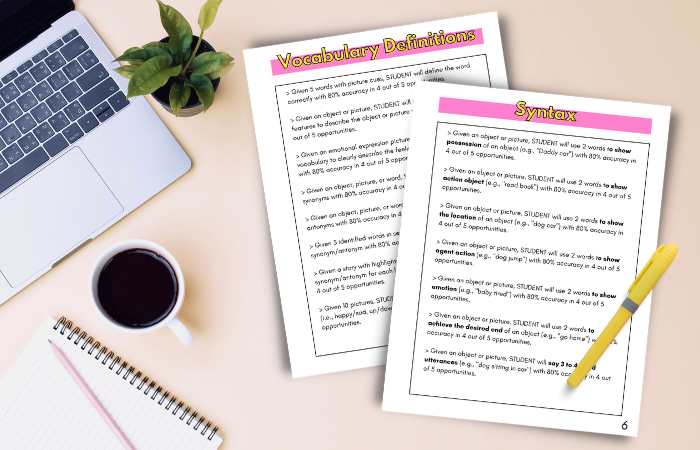
Creating Measurable and Functional Speech Goals
When developing comprehensive goal banks for IEPs, we ensure they are both measurable and functional, directly creating a path for visible progress and practical communication enhancement in various environments.
Sample Goals for Various Language Levels
- Goal: The child will use single words to make requests in 4 out of 5 opportunities.
Intermediate:
- Goal: The student will construct 4-word sentences to describe an event in 9 out of 10 trials with minimal prompts.
- Goal: The client will accurately narrate a past event using appropriate tense markers in 90% of observed opportunities.
Adapting Goals to the School Setting
Functional Communication:
- Goal: The child will request assistance during classroom activities using a full sentence in 4 out of 5 instances.
Integration with Academic Content:
- Goal: The student will use complex sentences to summarize a reading passage in oral form with 80% accuracy across four sessions.
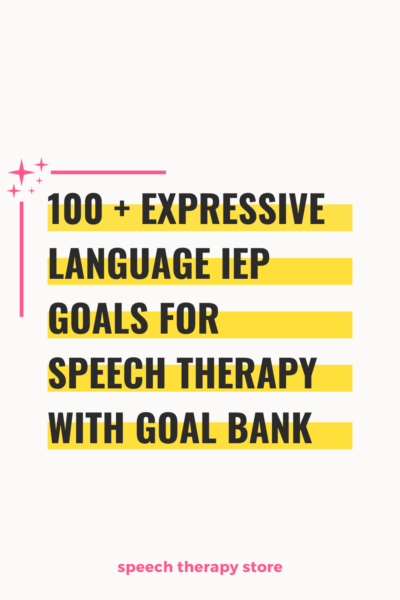
100+ Expressive Language Goals for Speech Therapy Goal Bank
Simply scroll to the bottom of this blog post to download a pdf of these 100+ Expressive Language Goals
Speech Therapy Goals for Expressive Language Delay
Utterance expansion, narrative development, gestures/signs, categorizations, similarities, differences, comparisons, multiple meanings, grammar structure, vocabulary definitions.
Given a writing or speaking task, STUDENT will use present progressive-tense verbs (i.g., walking, running, laughing) appropriately in a sentence or conversation with 80% accuracy in 4 out of 5 opportunities.
Given a writing or speaking task, STUDENT will use regular/irregular plural markers (i.g., apples/feet) appropriately in a sentence or conversation with 80% accuracy in 4 out of 5 opportunities.
Given a writing or speaking task, STUDENT will use article/number agreement (i.g., an apple/the boys) appropriately in a sentence or conversation with 80% accuracy in 4 out of 5 opportunities.
Given a writing or speaking task, STUDENT will use present-tense verbs (i.g., give, go, drink) appropriately in a sentence or conversation with 80% accuracy in 4 out of 5 opportunities.
Given a writing or speaking task, STUDENT will use future-tense verbs (i.g., will drive, will stop, will park) appropriately in a sentence or conversation with 80% accuracy in 4 out of 5 opportunities.
Given a writing or speaking task, STUDENT will use regular/irregular past-tense verbs (i.g., walked/ran) appropriately in a sentence or conversation with 80% accuracy in 4 out of 5 opportunities.
Given a picture or story, STUDENT will use nouns to answer WHO or WHAT questions with 80% accuracy in 4 out of 5 opportunities.
Given a picture or story, STUDENT will use verbs to tell actions with 80% accuracy in 4 out of 5 opportunities.
Given a picture or story, STUDENT will use prepositional phrase to answer WHERE questions with 80% accuracy in 4 out of 5 opportunities.
Given a picture or story, STUDENT will use prepositional phrase or adjective to answer HOW questions with 80% accuracy in 4 out of 5 opportunities.
Given an object or picture, STUDENT will use 2 words to call attention to an object (e.g., “this ball”, “my shoe”) with 80% accuracy in 4 out of 5 opportunities.
Given an object or picture, STUDENT will use 2 words to show the disappearance of an object (e.g., “no cracker”, “apple all gone”) with 80% accuracy in 4 out of 5 opportunities.
Given an object or picture, STUDENT will use 2 words to indicate recurrence of an object (e.g., “more cracker”) with 80% accuracy in 4 out of 5 opportunities.
Given an object or picture, STUDENT will use 2 words that contain an adjective and a noun (e.g., “big bear”) with 80% accuracy in 4 out of 5 opportunities.
Given an object or picture, STUDENT will use 2 words to show possession of an object (e.g., “Daddy car”) with 80% accuracy in 4 out of 5 opportunities.
Given an object or picture, STUDENT will use 2 words to show action object (e.g., “read book”) with 80% accuracy in 4 out of 5 opportunities.
Given an object or picture, STUDENT will use 2 words to show the location of an object (e.g., “dog car”) with 80% accuracy in 4 out of 5 opportunities.
Given an object or picture, STUDENT will use 2 words to show agent action (e.g., “dog jump”) with 80% accuracy in 4 out of 5 opportunities.
Given an object or picture, STUDENT will use 2 words to show emotion (e.g., “baby tired”) with 80% accuracy in 4 out of 5 opportunities.
Given an object or picture, STUDENT will use 2 words to achieve the desired end of an object (e.g., “go home”) with 80% accuracy in 4 out of 5 opportunities.
Given an object or picture, STUDENT will say 3 to 4-word utterances (e.g., “dog sitting in car”) with 80% accuracy in 4 out of 5 opportunities.
Given an activity, picture, or story, STUDENT will form grammatically correct simple sentences with 80% accuracy in 4 out of 5 opportunities.
Given an activity, picture, or story, STUDENT will use correct subject-verb agreement in sentences with 80% accuracy in 4 out of 5 opportunities.
Given an activity, picture, or story, STUDENT will use all necessary propositions in sentences with 80% accuracy in 4 out of 5 opportunities.
Given an activity, picture, or story, STUDENT will use compound sentences (i.e., and, but, or, etc.) with 80% accuracy in 4 out of 5 opportunities.
Given an activity, picture, or story, STUDENT will use correct subject-verb agreement with 80% accuracy in 4 out of 5 opportunities.
Given an object or picture, STUDENT will use 2-3 word utterances to describe the object or picture with 80% accuracy in 4 out of 5 opportunities.
Given an opportunity to ask a question/comment/describe, STUDENT will use 4-5 word utterances to ask a question/comment/describe with 80% accuracy in 4 out of 5 opportunities.
Given an orally presented sentence with missing words, STUDENT will identify missing words (i.e., articles, prepositions. etc.) with 80% accuracy in 4 out of 5 opportunities.
Given an opportunity to ask a question/comment/describe, STUDENT will include all necessary words in a sentence to ask a question/comment/describe with 80% accuracy in 4 out of 5 opportunities.
Given an object or picture, STUDENT will use descriptive words to describe the object or picture with 80% accuracy in 4 out of 5 opportunities.
Given an opportunity to express a want or need, STUDENT will use complete grammatically correct sentence to express HIS/HER want or need with 80% accuracy in 4 out of 5 opportunities.
Given an opportunity to tell past events, STUDENT will use simple complete grammatically correct sentence to tell about past events with 80% accuracy in 4 out of 5 opportunities.
Given an opportunity to express a want or need, STUDENT will use 2-4 words to express HIS/HER want or need with 80% accuracy in 4 out of 5 opportunities.
Given an opportunity to comment or share information, STUDENT will use2-4 words to express HIS/HER comment or share information with 80% accuracy in 4 out of 5 opportunities.
Given a wh-question, STUDENT will use2-4 words to answer simple Wh-questions (i.e., who, what, when, where, why, how) with 80% accuracy in 4 out of 5 opportunities.
Given visual cues (e.g., sequencing cards) and a story, STUDENT will sequence the story including problem and solution with 80% accuracy in 4 out of 5 opportunities.
Given a story or activity, STUDENT will sequence the story or activity that includes # parts with 80% accuracy in 4 out of 5 opportunities.
Given an opportunity to tell a story, STUDENT will use descriptive language to tell their story with 80% accuracy in 4 out of 5 opportunities.
Given an opportunity to tell a story from their past, STUDENT will tell their story with the appropriate number of details and in the right order with 80% accuracy in 4 out of 5 opportunities.
Given a story or activity, STUDENT will use sequence words to verbally order a story or activity (e.g., first, next, then, after, last) with 80% accuracy in 4 out of 5 opportunities.
Given a want or request, STUDENT will pair vocalizations with gestures when indicating a want or requesting an object with 80% accuracy in 4 out of 5 opportunities.
Given a want for “more”, STUDENT will use words and/or signs to ask for “more” with 80% accuracy in 4 out of 5 opportunities.
Given a task or activity, STUDENT will use words and/or signs to indicate HE/SHE is “finished” with 80% accuracy in 4 out of 5 opportunities.
Given a difficult task or activity, STUDENT will use words and/or signs to ask for “help” with 80% accuracy in 4 out of 5 opportunities.
Given a “yes” or “no” question, STUDENT will use words and/or signs to answer the question with “yes” or “no” with 80% accuracy in 4 out of 5 opportunities.
Given 10 common objects or pictures, STUDENT will verbally label the item with 80% accuracy in 4 out of 5 opportunities.
Given a common object, noun, or action, STUDENT will verbally label the item in a phrase or sentence with 80% accuracy in 4 out of 5 opportunities.
Given 10 common words, STUDENT will verbally name the word with 80% accuracy in 4 out of 5 opportunities.
Given 10 common words, STUDENT will verbally name the word in a phrase or sentence with 80% accuracy in 4 out of 5 opportunities.
SEE ALSO: IEP Goal Bank Posts
Given an object or picture, STUDENT will describe the object or picture by stating the function of the item with 80% accuracy in 4 out of 5 opportunities.
Given 10 words, STUDENT will describe the object or picture by stating the function of the word with 80% accuracy in 4 out of 5 opportunities.
Given a category, STUDENT will name (3-5) items in that category (e.g., school items, home items, clothing, animals, colors, toys, etc.) with 80% accuracy in 4 out of 5 opportunities.
Given 3 to 5 items in a category (e.g., dog, cat, fish, etc.), STUDENT will identify the category (e.g., school items, home items, clothing, animals, colors, toys, etc.) and explain their relationships with 80% accuracy in 4 out of 5 opportunities.
Given 3 to 5 items, STUDENT will identify the item that does not belong in the group and explain why with 80% accuracy in 4 out of 5 opportunities.
Given a category, STUDENT will name (3-5) items in that category and (1) item that does not belong in that category with 80% accuracy in 4 out of 5 opportunities.
Given 3 to 5 pictures, STUDENT will select 2 similar pictures and explain the similarities with 80% accuracy in 4 out of 5 opportunities.
Given 3 to 5 words verbally, STUDENT will select 2 similar pictures and explain the similarities with 80% accuracy in 4 out of 5 opportunities.
Given 3 to 5 pictures, STUDENT will select the different picture and explain the differences with 80% accuracy in 4 out of 5 opportunities.
Given a list of 3 to 5 words verbally, STUDENT will identify the different word and explain the differences with 80% accuracy in 4 out of 5 opportunities.
Given 3 to 5 words verbally, STUDENT will identify the different word and explain the differences with 80% accuracy in 4 out of 5 opportunities.
Given a word pair verbally, STUDENT will explain the primary difference between the two words with 80% accuracy in 4 out of 5 opportunities.
Given two object pictures, STUDENT will compare likeness(es) and difference(s) with 80% accuracy in 4 out of 5 opportunities.
Given two spoken words, STUDENT will compare likeness(es) and difference(s) with 80% accuracy in 4 out of 5 opportunities.
Given two concepts (e.g. flying vs. driving), STUDENT will compare likeness(es) and difference(s) with 80% accuracy in 4 out of 5 opportunities.
Given 2 pictures that represent different meanings of the same word , STUDENT will provide a definition for each with 80% accuracy in 4 out of 5 opportunities.
Given 2 sentences that represent different meanings of the same word, STUDENT will provide a definition for each with 80% accuracy in 4 out of 5 opportunities.
Given a multiple meaning word, STUDENT will provide 2 or more definitions for the multiple meaning word with 80% accuracy in 4 out of 5 opportunities.
Given an object or picture, STUDENT will describe the object or picture by identifying a minimum of (3) attributes (e.g., color, size, number etc.) with 80% accuracy in 4 out of 5 opportunities.
Given an object or picture and asked a question, STUDENT will answer the question by identifying a minimum of (5) attributes (e.g., color, size, number etc.) with 80% accuracy in 4 out of 5 opportunities.
Given 10 items presented verbally, STUDENT will describe the object or picture by identifying a minimum of (3) attributes (e.g., color, size, number etc.) with 80% accuracy in 4 out of 5 opportunities.
SEE ALSO: 179+ Wh Questions Free Printable
Given an object, picture, or story, STUDENT will say a complete sentence using articles (i.e., “a”, “an”, “the”, and “some”) with 80% accuracy in 4 out of 5 opportunities.
Given an object, picture, or story, STUDENT will say a complete sentence using demonstrative adjectives (i.e., “this”, “that”, “these”, and “those”) with 80% accuracy in 4 out of 5 opportunities.
Given an object, picture, or story, STUDENT will say a complete sentence using plural nouns (i.e., s, es, and irregular plural forms) with 80% accuracy in 4 out of 5 opportunities.
Given an object, picture, or story, STUDENT will say a complete sentence using possessive nouns (i.e., “the girl’s book”) with 80% accuracy in 4 out of 5 opportunities.
Given an object, picture, or story, STUDENT will say a complete sentence using subject pronouns (i.e., “I”, “he”, “she”, “you”, “we”, “they”) with 80% accuracy in 4 out of 5 opportunities.
Given an object, picture, or story, STUDENT will say a complete sentence using object pronouns (i.e., “me”, “him”, “her”, “you”, “us”, “them”) with 80% accuracy in 4 out of 5 opportunities.
Given an object, picture, or story, STUDENT will say a complete sentence using possessive pronouns (i.e., “my”, “mine”, “his”, “her/hers”, “you/yours”, “our/ours”, “their/theirs”) with 80% accuracy in 4 out of 5 opportunities.
Given an object, picture, or story, STUDENT will say a complete sentence using reflexive pronouns (i.e., “myself”, “himself”, “herself”, “yourself”, “yourselves”, “ourselves”, “themselves”) with 80% accuracy in 4 out of 5 opportunities.
Given an object, picture, or story, STUDENT will say a complete sentence using present progressive verb tense (i.e., “The girl is running”) with 80% accuracy in 4 out of 5 opportunities.
Given an object, picture, or story, STUDENT will say a complete sentence using past progressive verb tense (i.e., “The girl was running”) with 80% accuracy in 4 out of 5 opportunities.
Given an object, picture, or story, STUDENT will say a complete sentence using present tense “s” and “es” marker (i.e., “The girl runs”) with 80% accuracy in 4 out of 5 opportunities.
Given an object, picture, or story, STUDENT will say a complete sentence using “has”/”have” (i.e., “The girl has a book”) with 80% accuracy in 4 out of 5 opportunities.
Given an object, picture, or story, STUDENT will say a complete sentence using regular past tense (i.e., “The boy waited for the bus.”) with 80% accuracy in 4 out of 5 opportunities.
Given an object, picture, or story, STUDENT will say a complete sentence using irregular past tense (i.e., “ran”, “drove”, “drank”) with 80% accuracy in 4 out of 5 opportunities.
Given an object, picture, or story, STUDENT will say a complete sentence using conjunctions (i.e., “and”, “or”, “but”, “because”, “if”, “since”) with 80% accuracy in 4 out of 5 opportunities.
Given an object, picture, or story, STUDENT will say a complete sentence using future tenses (i.e., “The boy will go to school”) with 80% accuracy in 4 out of 5 opportunities.
Given an object, picture, or story, STUDENT will say a complete sentence using negative sentence structures (i.e., “will not/won’t”, “does not/doesn’t”) with 80% accuracy in 4 out of 5 opportunities.
Given an object, picture, or story, STUDENT will ask yes/no questions (i.e., “Is the boy hurt?”) in a complete sentence with 80% accuracy in 4 out of 5 opportunities.
Given an object, picture, or story, STUDENT will ask WH questions (i.e., “What is the girl doing?”) in a complete sentence with 80% accuracy in 4 out of 5 opportunities.
Given an object, picture, or story, STUDENT will say a complete sentence using comparatives (i.e., “The kitty is smaller than the tiger”) with 80% accuracy in 4 out of 5 opportunities.
Given an object, picture, or story, STUDENT will say a complete sentence using superlatives (i.e., “That is the best cookie.”) with 80% accuracy in 4 out of 5 opportunities.
Given an idiom with a visual cue, STUDENT will accurately describe the meaning of the idiom with 80% accuracy in 4 out of 5 opportunities.
Given an idiom verbally with no visual cue, STUDENT will accurately describe the meaning of the idiom with 80% accuracy in 4 out of 5 opportunities.
Given an idiom verbally, STUDENT will identify a social situation where the idiom may be used appropriately with 80% accuracy in 4 out of 5 opportunities.
Given 5 words with picture cues, STUDENT will define the word correctly with 80% accuracy in 4 out of 5 opportunities.
Given an object or picture, STUDENT will use 2-3 critical features to describe the object or picture with 80% accuracy in 4 out of 5 opportunities.
Given an emotional expression picture or story, STUDENT will use vocabulary to clearly describe the feelings, ideas, or experiences with 80% accuracy in 4 out of 5 opportunities.
Given an object, picture, or word, STUDENT will identify synonyms with 80% accuracy in 4 out of 5 opportunities.
Given an object, picture, or word, STUDENT will identify antonyms with 80% accuracy in 4 out of 5 opportunities.
Given 5 identified words in sentences, STUDENT will provide a synonym/antonym with 80% accuracy in 4 out of 5 opportunities.
Given a story with highlighted words, STUDENT will provide a synonym/antonym for each highlighted word with 80% accuracy in 4 out of 5 opportunities.
Given 10 pictures, STUDENT will match opposite pictures in pairs (i.e., happy/sad, up/down) with 80% accuracy in 4 out of 5 opportunities.
Given an object, picture, or word, STUDENT will identify the opposite with 80% accuracy in 4 out of 5 opportunities.
Given an object or picture, STUDENT will describe the object or picture by naming the item, identify attributes (color, size, etc.), function, or number with 80% accuracy in 4 out of 5 opportunities.
Given a reading task, STUDENT will define unfamiliar words using context clues with 80% accuracy in 4 out of 5 opportunities.
Given common academic vocabulary, STUDENT will define prefix and/or suffix with 80% accuracy in 4 out of 5 opportunities.
Given common academic vocabulary, STUDENT will define the vocabulary word using a complete sentence with correct grammar with 80% accuracy in 4 out of 5 opportunities.

Assessment and Progress Tracking
Data collection and utilizing iep goals.
We meticulously collect data on each interaction that pertains to our client’s IEP goals. Crafting a well-structured IEP goal bank allows us to select targets that are measurable and aligned with the client’s specific needs.
As we collect this date, we cross-reference this information with our IEP goal bank to ensure consistency and completeness in our data collection efforts.
If you’re a classroom teacher or speech pathologists in need of data tracking forms while working on your student’s goals for speech-language therapy then be sure to check out my IEP goal data tracking for progress monitoring forms .
Or if you simply want a list of data sheets to choose from then be sure to check out my list of 35 free speech therapy data sheets roundup .
SEE ALSO: 21 Best Reinforcement Games for Speech Therapy
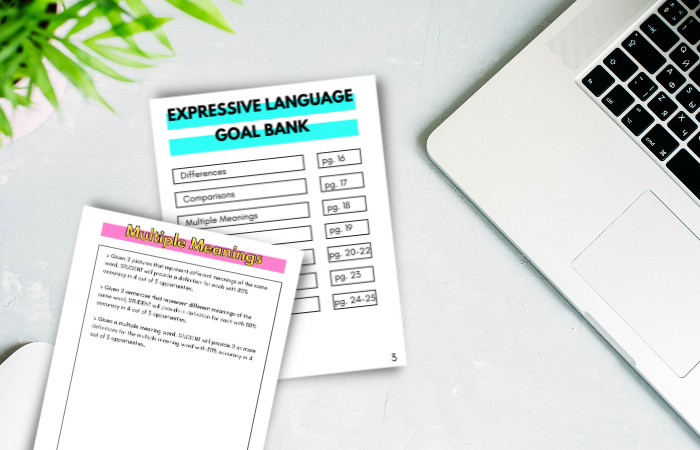
Therapeutic Techniques and Activities
We understand that the efficacy of speech therapy relies heavily on targeted therapeutic techniques and activities. These strategies are meticulously designed to foster language development and improve expressive skills.
Here, we discuss two fundamental approaches: Structured Language Activities and Using Picture Scenes and Cards.
Structured Language Activities
Structured language activities are the cornerstone of our therapeutic approach. These activities provide a controlled environment where we can isolate specific linguistic skills for practice and reinforcement. For instance:
- Modeling : We offer models of correct language use, which clients can recognize and reproduce.
- Repetition : Clients are encouraged to practice specific words or sentence structures repeatedly to build proficiency.
Here are some of our favorite structured language activities to help accomplish speech therapy goals!
- Nobody Hugs A Cactus Structured Narrative Retell by BJT the SLP at Communication Reigns is a short story with specific objectives to build school aged language skills! Short stories play a crucial role in answering verbal prompts to build comprehension. This bundle offer WH Questions and types for fading cues so that all students have their necessary support.
- Speech Therapy: FREE Expressive Language Program by Speech Chick Alissa Halloway is a great way to use visual prompts and verbal prompts in a structured activity. This freebie is highly rated!
- Weekly Agenda / Learning Targets / Student Reflection by Expressive ELA Education is a great resource to add to your treatment plan! Students practice conversational skills and social skills as they are prompted through the plan for the week.
Using Picture Scenes and Cards
Picture scenes and cards elevate the engagement and contextuality of our therapy sessions. These tools help clients visualize and conceptualize language in relatable scenarios.
Picture Scenes : We use detailed scenes to encourage clients to describe activities, tell stories, and develop narrative skills. Picture Cards : These are used for more focused work on specific vocabulary, categorization, and articulation tasks.
Here are some great picture scenes and picture card resources for you!
- FREEBIE! Describing with your Senses Vocabulary/Word Finding Game BOOM CARDS by SLP Style is an engaging picture scene that prompts students to use social language and talk through their senses
- Expressive Language – What do you see at the beach? By Listen Speak Learn offers picture cues to talk about what is seen at the beach.
- Body Parts – Expressive and Receptive Identification by Our Impact is a great way to practice expressive language goals as students practice labeling body parts.

Blog Post Resources
Here are all my Speech Therapy Store blog posts for working on expressive language skills that you might also find helpful!
- 33 Most Common Irregular Plurals Flashcards – Download this first post of free irregular plurals with their real-life photos.
- 253+ Yes or No Questions for Speech Therapy – Here is a massive resource working on answering yes or no questions.
- 179+ Wh Questions Free Printable – Grab this freebie to work on answering wh-questions.
- 197+ Best Wh Questions Speech Therapy Activities – If you have a child or student working on wh-question you’ll also want to check out this list of helpful free resources.
- 31+ What Questions for Speech Therapy – Have your child or student watch these wordless videos and then answer the “what” question using the interactive quiz with instant feedback.
- 31 Best Wordless Videos to Work on Answering Questions – Have your student watch these fun animated wordless videos and then answer the included wh-questions.
- Nature Themed Bundle – This bundle includes yes/no questions, wh-questions, pronouns, regular past tense verbs, and irregular past tense verbs.
- Technology Themed Bundle – This bundle also includes yes/no questions, wh-questions, pronouns, regular past tense verbs, and irregular past tense verbs.
Need Other IEP Goals?
Are you a speech language pathologist looking for other effective iep goals for speech? If so, be sure to check out my master list of IEP goals here .
This list of goal writing ideas also includes the following speech pathology goals:
- Figurative Language
- Final Consonants
- Prepositional Phrase
- Context Clues
- Articulation Goals (Single Word Level, Phrase Level, Sentence Level, and Conversation)
- Communication Device – Nonverbal Communication
These are just a few of the possible goal combinations listed on this master list of over 432 IEP goals made for a speech therapist.
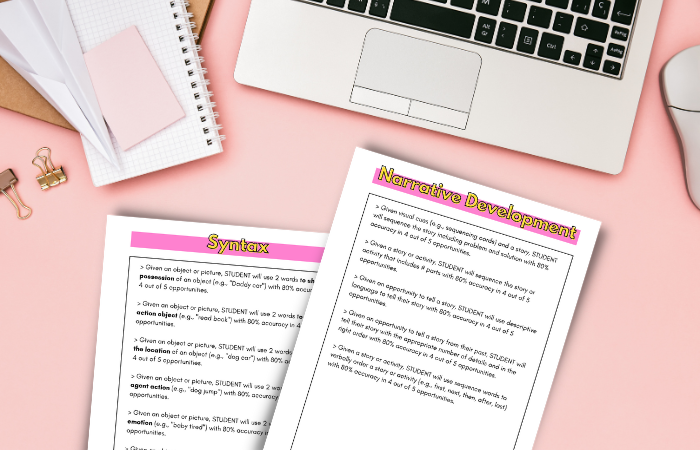
<< Fill out the Form to grab your free 100+ Expressive Language Goals PDF >>
Grab your expressive language iep goal bank, frequently asked questions :, expressive language goals for speech therapy.
In this section, we provide a thorough overview of common inquiries surrounding expressive language goals in speech therapy, particularly as they relate to children and early intervention programs.
What objectives are typically included in expressive language goals for speech therapy?
We often target the enhancement of vocabulary, the correct use of grammar, the ability to construct sentences, and the skill of relaying information or needs. Increasing the variety and complexity of spoken language is also a primary objective.
How can one formulate effective long-term goals for expressive language development in speech therapy?
We focus on creating goals that are achievable and measurable, tailored to the child’s current abilities and potential for growth. Goals are plotted out over a period, with milestones that align with the child’s developmental stage.
Can you provide examples of expressive language goals for early intervention programs?
Certainly. We set goals like expanding the child’s vocabulary, encouraging the use of two to three-word phrases, and improving the clarity of speech. Another example is prompting the child to initiate communication.
What strategies are used to establish expressive communication goals in therapy?
We use a detailed assessment of a child’s current language abilities to establish baselines, then leverage those findings to set individualized goals. Strategies may include play-based learning or structured activities.
How do therapists measure progress towards expressive language goals in speech therapy?
Progress is measured through consistent tracking of therapy sessions, using tools such as language samples, direct observation, and standardized tests. We look for signs of improvement in the child’s ability to express themselves.
What are some common goals set for 3-year-olds to enhance expressive language skills?
For 3-year-olds, we often set goals aimed at increasing sentence length, improving story-telling skills, and fostering the use of pronouns and prepositions, reflecting typical language development milestones for this age group.
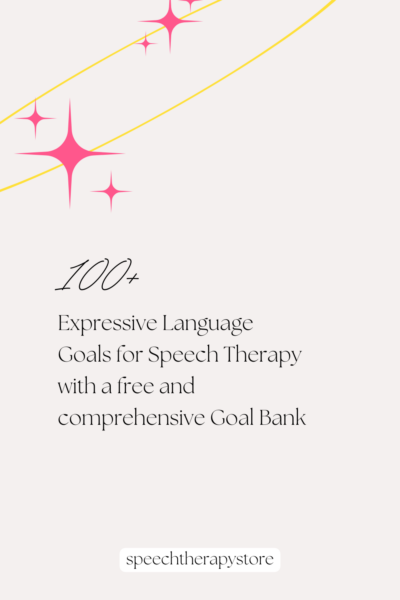
Want Even More Expressive Language Goals for Speech Therapy?
- Free SLP Planner [Updated Yearly]
- 917+ Best Free Boom Cards for Speech Therapy
- 31 Best Wordless Videos to Teach Problem Solving
- 133+ Categories List for Speech Therapy
- The Best Handout for Phonological Processing Disorder Therapy
Want the Best of the Bests?
Be sure to check out our most popular posts below!
- 21 Best Reinforcement Games for Speech Therapy / Teletherapy
- Best IEP Resources
- 71+ Free Social Problem-Solving Scenarios
- 430+ Free Multisyllabic Words List Activity Bundle
- 432+ Free Measurable IEP Goals and Objectives Bank
- 279+ Free Speech Therapy Digital Materials
- 179+ Free Speech Therapy Wh-Questions Printable

Your cart is currently empty.
Total: $0.00
Expressive Language Goal Bank
- (client) will independently label age-appropriate objects with 80% accuracy for 3 data collections.
- (client) will name a described object with 80% accuracy for 3 data collections.
- (client) will name 5 items from a category with 80% accuracy for 3 data collections.
- (client) will imitate 1-2 word utterances 10x times per session for 3 sessions.
- (client) will imitate 10 different two word phrases to request, protest, comment, or get attention over 3 consecutive sessions.
- (client) will use a carrier phrase to form a simple sentence given picture cues in 80% of opportunities for 5 data collections.
- (client) will use 2-3 word phrases in 80% opportunities to participate in play and shared book reading for 3 data collections.
- (client) will produce 3-4 word phrases to request, protest, and/or comment 10x per session for 3 consecutive sessions.
- (client) will produce a complete, relevant sentence about a given stimuli in 80% of opportunities for 3 data collections.
- (client) will produce complete, grammatical sentences of 4+ words within structured activities in 80% pf opportunities for 5 data collections.
- (client) will increase sentence length using modifier words or phrases (adjectives, prepositions, etc.) when prompted in 80% of opportunities for 3 data collections.
- (client) will use descriptive concept words (color, size, shape, etc) with 80% accuracy for 5 data collections.
- (client) will use spatial concept words (in, on, next to, etc) with 80% accuracy for 5 data collections.
- (client) will use temporal concept words (now, yesterday, next week, etc) with 80% accuracy for 5 data collections.
- (client) will use quantitative concept words (all, some, rest, etc) with 80% accuracy for 5 data collections.
- (client) will produce modified noun phrases using color, shape, and/or size (e.g. blue ball) with 80% accuracy for 5 data collections.
- (client) will tell how two things are the same giving attributes ie. category, color, shape, or function with 80% accuracy for 3 data collections.
- (client) will answer what/where/when/who/why questions about pictures or play with 80% accuracy for 3 data collections.
- (client) will answer what/where/when/who/why questions during conversations with 80% accuracy for 3 data collections.
- (client) will answer questions in concise manner without using circumlocution in 80% of opportunities across 3 data collections.
- (client) will answer how questions accurately to include multiple steps (e.g. how do you brush your teeth? how do you make your bed?) with 80% accuracy for 3 data collections.
- (client) will retell stories to include 80% of relevant details across 3 data collections.
Made with love in Austin, Texas
© 2020 Shine Speech Activities
Product Added To Your Cart
There are 0 Items In Your Cart
Total Price: $0.00
Compare Product
SUBSCRIBE TO STAY CONNECTED!
Speech Room News
Speech & Language Therapy Resources
IEP Goal Bank
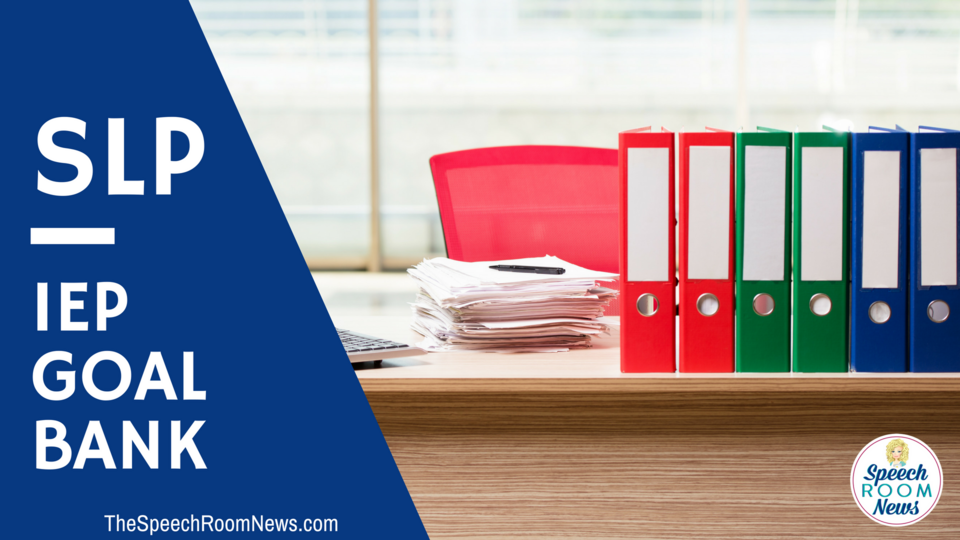
The following is a sample of some goals I write for students with communication disorders. Please feel free to bookmark this page and reference when writing goals and objectives. You make share a link to this page. You may not copy/paste this set of goal and share it as you own or post it in its entirety on a separate website. Happy Goal Writing!
Join the SRN newsletter!

I'm so glad you stopped by! If you'd like to keep up with the newest posts and get exclusive free downloads, please sign up for the newsletter! Your first freebie is ready as soon as you subscribe and confirm your email!
Success! Now check your email to confirm your subscription.
There was an error submitting your subscription. Please try again.
Keep up with the newest posts and get exclusive free downloads!

How to Write Expressive Language Goals [with goal bank]
Expressive language goals focus on an individual’s use of language. This post will explain how to write goals to address expressive language in intervention using the Communication Community Goal Writing Formula!
Our comprehensive goal banks for school-aged language, AAC, Early Intervention & preschool, and fluency are available on our site or Teachers Pay Teachers store !
Save time creating goals with over THOUSANDS of possible goal combinations. Select your own combination of DO + CONDITION + CRITERION (and consistency) statements to develop personalized and measurable goals for your caseload.

What is expressive language?
Expressive language is the use of language, whereas receptive language is the understanding of language. there are five domains of language , including phonology, morphology, syntax, semantics and pragmatics. when developing expressive language goals, examining each of these domains is important so that the specific areas of need are targeted. for example, if an individual has adequate syntactical skills when using language, but does not have adequate semantic skills, goals should focus on semantics., who needs expressive language goals.
Expressive language goals are developed once it has been determined that an individual qualifies for speech-language intervention. This is done through a formal evaluation by a speech-language pathologist (SLP), and includes formal and informal assessments. Expressive language areas may include the use of developmentally-appropriate vocabulary, grammar, morphology, and more. Some individuals who have expressive language goals are children with language delays and individuals who have deficits in language due to a brain injury or a stroke.
What if someone uses sign language or an AAC system?
Individuals may use multiple types of communication modalities when expressing language, including speaking, sign language, or AAC. Many individuals use multiple communication modalities, such as speaking and AAC. When developing expressive language goals, consider what types of communication modalities individuals will be using and include that in the goal as well.
Writing Expressive Language Goals
Below you will find our Communication Community Goal Writing Formula that we use for writing all communication goals (e.g., receptive, expressive, pragmatic, etc.).
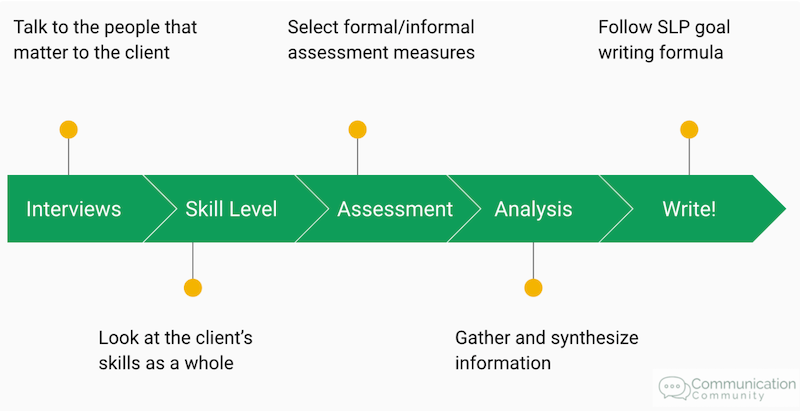
As seen above, speech goals should be written with 3* components in mind: the DO statement, the CONDITION statement, and the CRITERION statement.
*Also commonly included is consistency (we incorporate this!). Aka does the individual have to meet a specific criterion more than once? A common example of this may include across 3 consecutive sessions. This is usually something understood by the therapy organization/service provider and is sometimes/sometimes not included in the written goal itself. This is to ensure that the skill has been generalized and provides more reliable data that the skill has been properly mastered.
DO statement
What the client is actually going to DO and the specific skill they will be working towards. Example: produce a grammatically correct simple sentence
CONDITION statement
The specific setting and/or context your client will work on this skill. Example: during structured language activities
CRITERION statement
How the client’s performance will be measured. Example : in 9 out of 10 trials
DO + CONDITION + CRITERION
Example: [Client] will produce a grammatically correct simple sentence, during structured language activities, in 9 out of 10 trials.
There you have it! That is an example using our Goal Writing Formula containing the DO + CONDITION + CRITERION (don’t forget to think about consistency!) for an expressive language skill area.
Expressive Language Goal Bank
This goal bank includes a range of goals across phonology, morphology, syntax, and semantics. We have an entire post on pragmatic language goals as well. You may take parts of each goal (e.g. the DO from one and the CONDITION from another) in order to create the best goals for your individual.
- Example 1* : [Client] will verbally use accurate phonemes (e.g. /h/ in “hat”) in words and phrases, during structured language activities, in 4/ 5 opportunities.
* note this is not due to the client’s inability to produce specific phonemes, which would be considered an articulation or phonological disorder. This refers to understanding that the /h/ sound is significant to the meaning of the word “hat.”
- Example 2 : [Client] will accurately fingerspell functional words (e.g. their name), when completing classroom tasks, with 80% accuracy across 2 consecutive sessions.
- Example 1 : [Client] will use the bound morpheme -s to express plurality, verbally and in writing, when completing grade-level assignments, in 8/10 opportunities.
- Example 2 : [Client] will accurately use regular past tense using multimodal communication (signs, AAC, words), in small group sessions, with 90% accuracy, in 2 out of 3 sessions.
Syntax (grammar)
- Example 1 : [Client] will produce simple sentences containing a noun + verb (e.g. The boy eats) using multimodal communication, during structured and unstructured language activities, in 9/10 opportunities, across 3 consecutive sessions.
- Example 2 : [Client] will verbally answer simple wh- questions (who, what, where, when, why, how) using grammatically correct simple and compound sentences, during structured tasks, in 8/10 opportunities.
- Example 3 : [Client] will produce simple sentences using irregular past verb tenses (went, was, knew, have, etc) using multimodal communication, during group activities, in 9/ 10 opportunities.
- Example 4 : [Client] will write compound sentences using coordinating conjunctions (for, and, nor, but, or, yet, so), during structured language tasks, with 75% accuracy in three out of four sessions.
- Example 5 : [Client] will write complex sentences using one independent clause and at least one dependent clause, as a response to a question or prompt, with 80% accuracy.
- Example 6 : [Client] will use multimodal communication to produce simple sentences with a present verb tense, during small group sessions, in 4/ 5 opportunities.
- Example 7 : [Client] will use multimodal communication to produce compound and complex sentences, during classroom and social settings, in 9/ 10 trials.
Semantics (vocabulary)
- Example 1 : [Client] will use multimodal communication to produce figurative language (similes, metaphors, hyperboles, personifications, etc), during structured language activities, in 7/ 10 opportunities.
- Example 2 : [Client] will accurately use taught vocabulary words, during structured language activities, with 90% accuracy.
- Example 3 : [Client] will provide a synonym or antonym for a presented word, during structured language tasks, in 8/ 10 opportunities.
Combination
Many expressive language domains overlap, and many individuals with expressive language difficulties require intervention in more than one domain. Additionally, higher-level metacognitive skills related to expressive language may require intervention for achievement. Below are some goals to reflect skills in multiple domains and metacognitive skills.
- Example 1 : [Client] will produce 1-2 sentences verbal narratives about stories, passages, or videos using correct morphology, grammar, and vocabulary, during small group sessions, with 80% accuracy.
- Example 2 : [Client] will use multimodal communication to compare and contrast elements of stories, passages, or videos using simple and compound sentences with relevant vocabulary, during structured language activities, with 90% accuracy across 2 consecutive sessions.
- Example 3 : [Client] will use metacognitive strategies (e.g. planning tasks, using graphic organizers) to produce age-appropriate written work, in academic assignments, in 4 / 5 opportunities.
- Example 4 : [Client] will produce 1-2 paragraph written narratives about stories, passages, or videos using correct morphology, grammar, and vocabulary, in academic assignments or structured language tasks, with 80% accuracy.
Looking for more? More GOALS posts:
- How to Write Pragmatic Language Goals
- How to Write Receptive Language Goals
- How to Write AAC Goals
- How to Write Play Skills Goals
- How to Write Articulation Goals
- How to write Fluency Goals (Stuttering)
- How to Write Voice Disorders Goals
- How to Write Cluttering Goals
- How to Write Phonological Awareness Goals

Want to know how we prep ourselves for goal-writing (and more)?
These are some of our favorite resources for working:
- Clipboard with storage - we use ours ALL THE TIME!
- Some really nice pens - the feel of a pen that writes so well...priceless.
- Blue light glasses - for when excessive screen time is just...necessary
Happy writing!
This post contains some affiliate links and we may be (slightly) compensated if you use them, but all opinions are our own. We appreciate the support!
Citations/further resources
https://www.asha.org/practice-portal/clinical-topics/written-language-disorders/intervention-target-areas/
https://www.asha.org/practice-portal/clinical-topics/spoken-language-disorders/
https://www.asha.org/practice-portal/clinical-topics/written-language-disorders/
You might also like
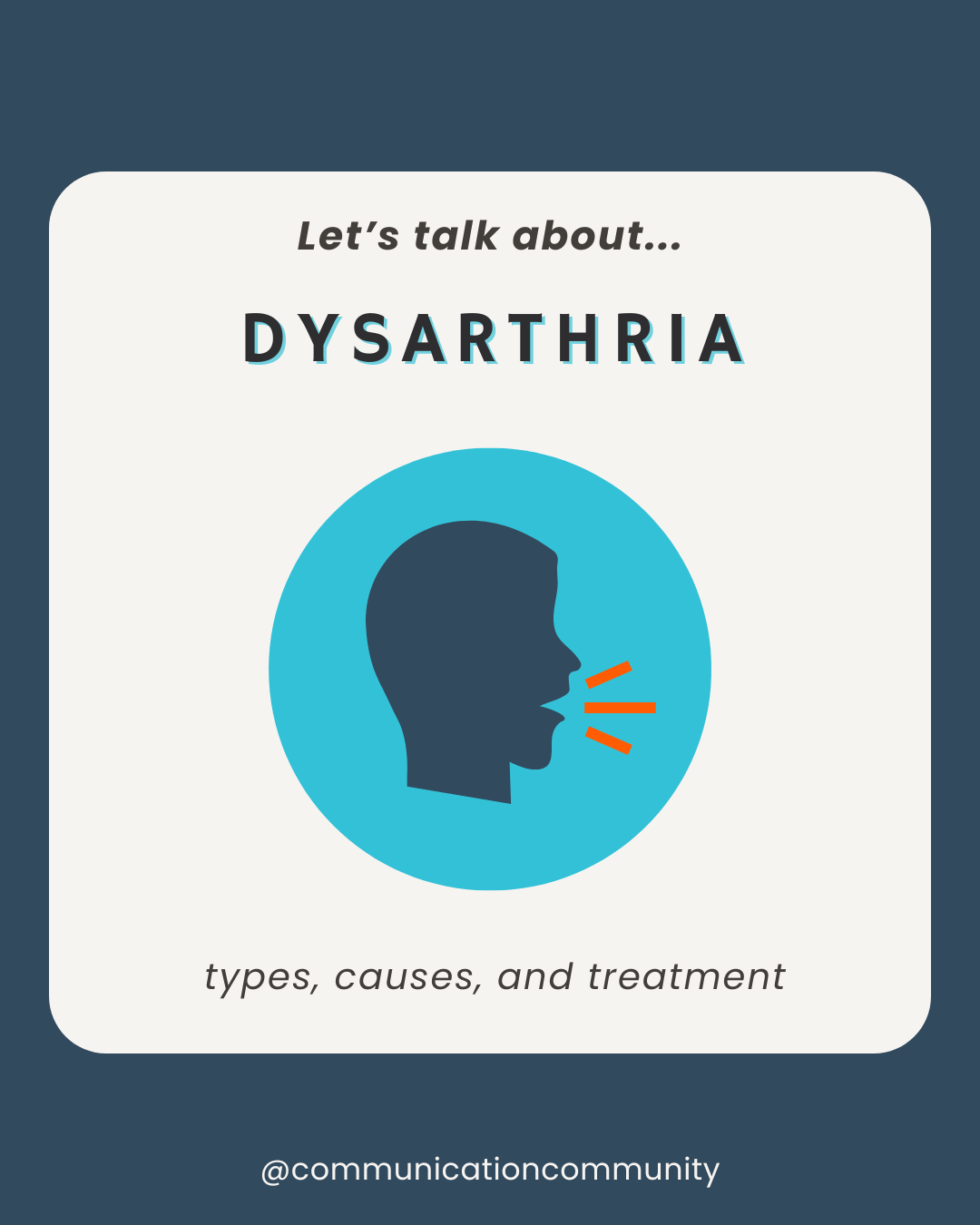
What is Dysarthria? (7 Types, Causes, and Treatment)
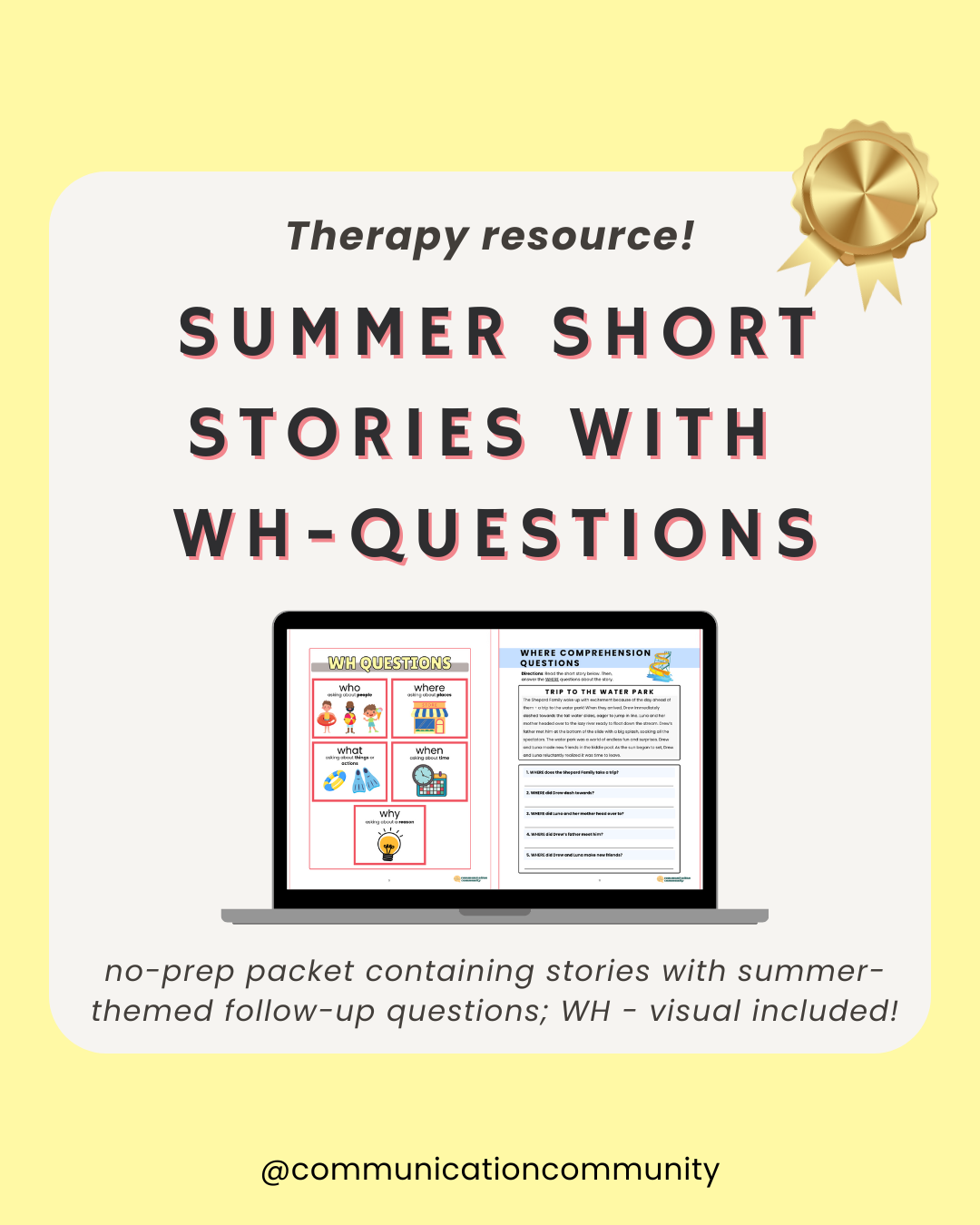
Summer Short Stories with WH Comprehension Questions for ELA/Speech Therapy
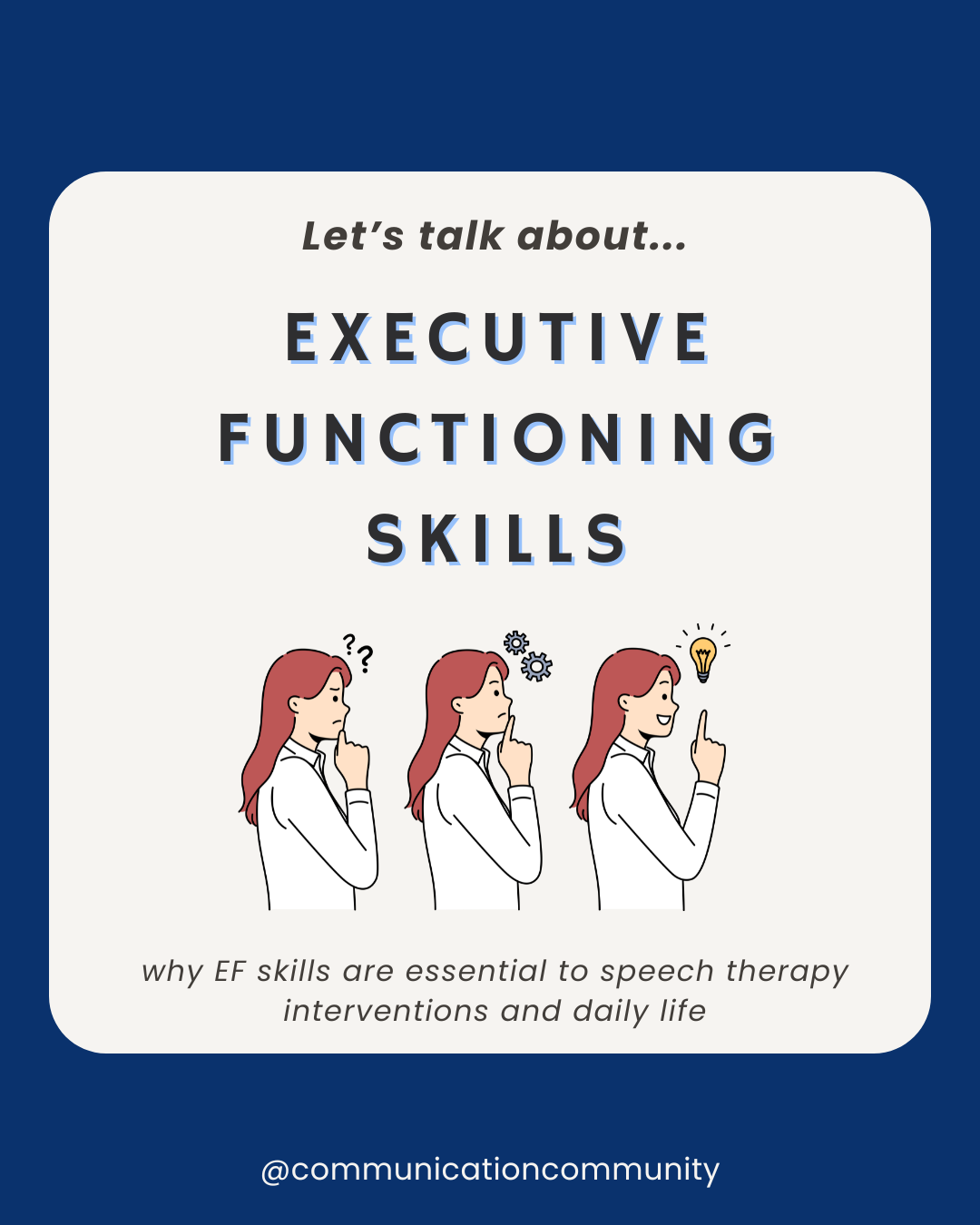
Executive Functioning and Speech Therapy: Why is it Relevant to Treatment and Day-to-Day Life?
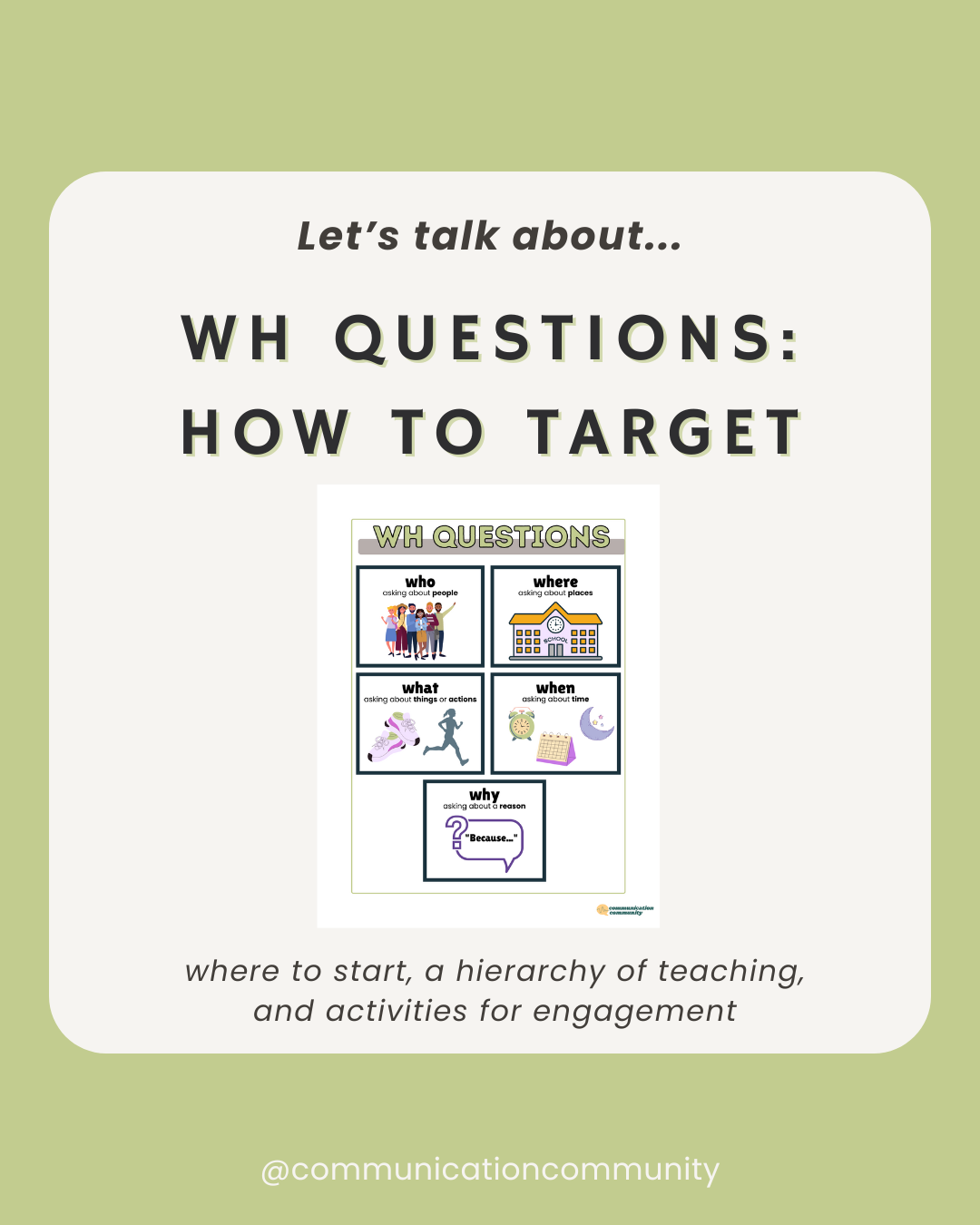
WH Questions for Speech Therapy: How to Target
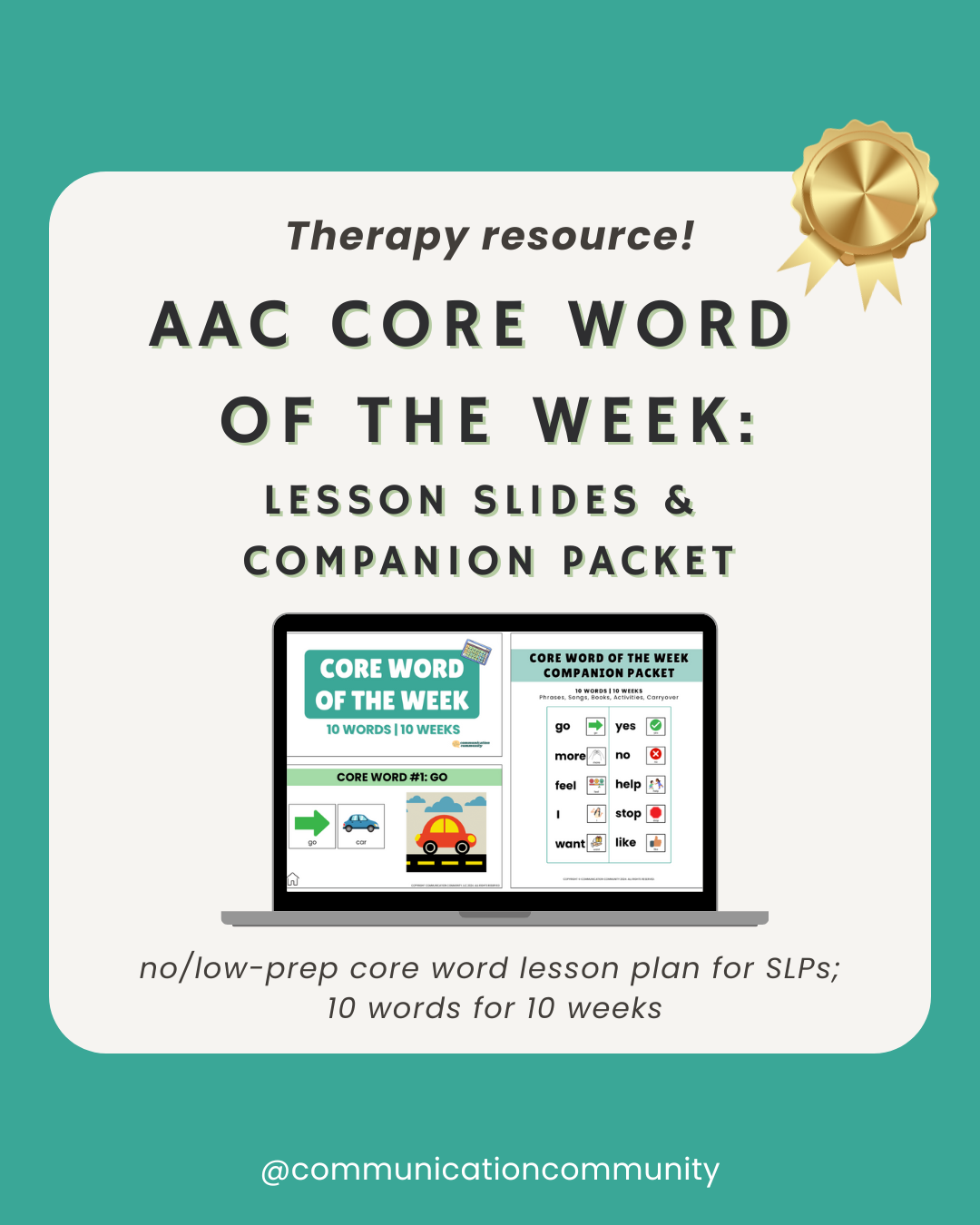
AAC Core Word of the Week Resource: Lesson Slides AND Companion Packet
Subscribe to new posts., subscribe to be notified of new content and support communication community, help keep this site independent..


How to Write Brilliant Speech Therapy Language Goals with Ease
- March 12, 2023
Ready to learn how to write speech therapy language goals to meet all of your students’ needs? Here are all of my favorite, go-to tips for writing speech therapy goals for expressive language and speech therapy receptive language goals. I have also included a link to my Speech IEP Goal Bank to save you even more time! This bank includes speech therapy articulation goals, speech therapy language goals for kindergarten, preschool speech therapy language goals, and so much more!
To access my IEP goal bank and some of my other favorite freebies, sign up below!
Speech Therapy Goal Writing
One thing I struggled with the most when I was starting out my first year was quickly and easily writing new IEP goals or updating old goals for students on my caseload. I tended to overthink and write and rewrite my goals until they were just right for my students, making it really hard on myself. For more on my journey as a school SLP, click here.

Now 10 years in, I have created a goal bank for myself of ideas in my head and on paper that are my go-to starting points when writing an IEP. These basic goals give me a good starting point when writing my IEPs and then all I have to do is go in and individualize based on that student’s needs. Now, is absolutely everything included here? No. Will there always be outliers or students with totally different needs? Absolutely. After all, this is the schools and we just never know what each year will bring. However, we can be pretty sure we’ll need a couple of key goals in the main areas we see year after year. For me, that would be Arctic, Vocabulary, Organization, Fluency, and Comprehension.
How to Write Speech Therapy Language Goals
Goals should be written to be specific, measurable, attainable, relevant and time-based. Let’s break some of these down.
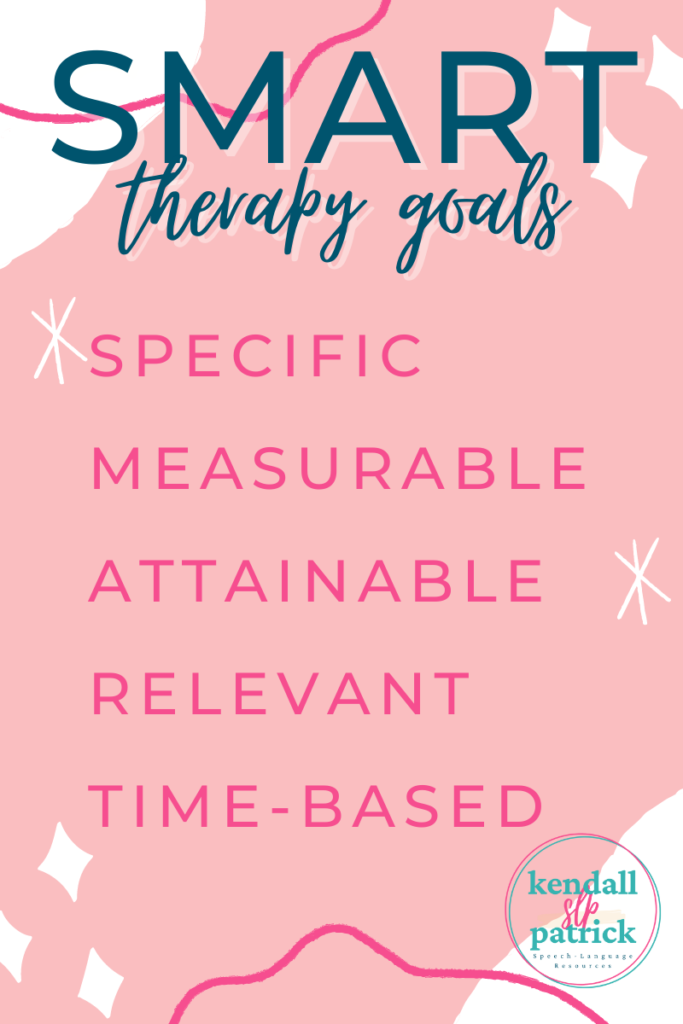
Specific – your IEP goals should be specific and define exactly what you were wanting to be accomplished. They should also specify who will accomplish it and what steps will be taken to accomplish it.
Measurable – your IEP goal should be measurable so that you can track progress and easily be able to tell when they are mastered.
Attainable – your IEP goal should be attainable. This means it’s a goal that the student can meet within a reasonable amount of time (typically within the school year or one calendar year). And remember it should be specific to the student so if that student’s accuracy is currently at 0% an attainable goal for them may be 50 to 60%, not 80.
Relevant – your IEP goal should be related to the big picture. Ask yourself what you are trying to accomplish or what you want the student to accomplish with this goal. Whether it’s gaining access to grade-level material in the classroom or building the foundational skills they need in order to gain those age-appropriate skills. Make sure it is relevant to that student’s specific means, not just based on a norm-referenced test item.
Time-based – last but not least make sure your IEP goal is time-based. Have a date and time in which the goal is expected to be mastered, whether it’s by the end of the school year, by the next grade level, or by the IEP expiration date.
Speech Therapy Expressive Language Goals
Speech therapy goals for expressive language can be tricky at times, but I’m here to share my best goal-writing and implementation tips. I find it easiest to have a few good core goals ready to go that I can then individualize depending on the student and their needs. Keeping a steady log of these goals makes IEP goal writing so much easier.
During structured therapy tasks, STUDENT will apply an organizational strategy to provide 3 to 4 details when defining/describing presented vocabulary as measured by therapy data and/or student product.
- STUDENT will express regular past tense verbs from pictures with 80% accuracy as measured by therapy data and observations.
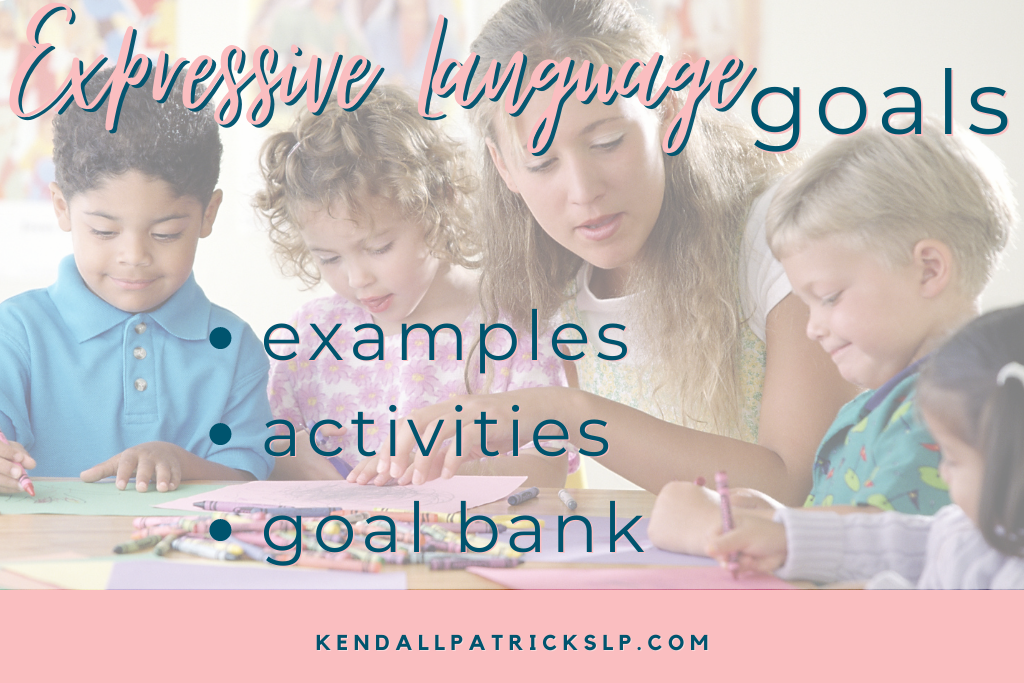
Speech Therapy Receptive Language Goals
Receptive language refers to the way our students receive and understand language (e.g., listening and reading).
Here are some examples of receptive language goals:
- During structured therapy tasks, STUDENT will identify word relationships (e.g., categories, functions, parts of a whole) through picture sorts and matching tasks with 75% accuracy as measured by therapy data.
- STUDENT will follow directions with positional concepts (e.g., under, over, in front of, behind) with 80% accuracy as measured by therapy data and observations.

More IEP Goals for Communication
Below are some example smart IEP goals that I may write for my students working on articulation, language, or fluency.
- By the end of this IEP cycle, STUDENT will ________ in structured therapy tasks with ____% accuracy with visual cues only, as measured by therapy data and observations.
- By the end of this IEP cycle, STUDENT will apply _______ strategies in structured speaking tasks (e.g., answering questions, describing, story retell) in _____ out of 5 attempts independently as measured by therapy data and observations.
- By the end of this IEP cycle, STUDENT will accurately produce the following sounds: _________ in words and phrases with 80% accuracy as measured by therapy data and observations.
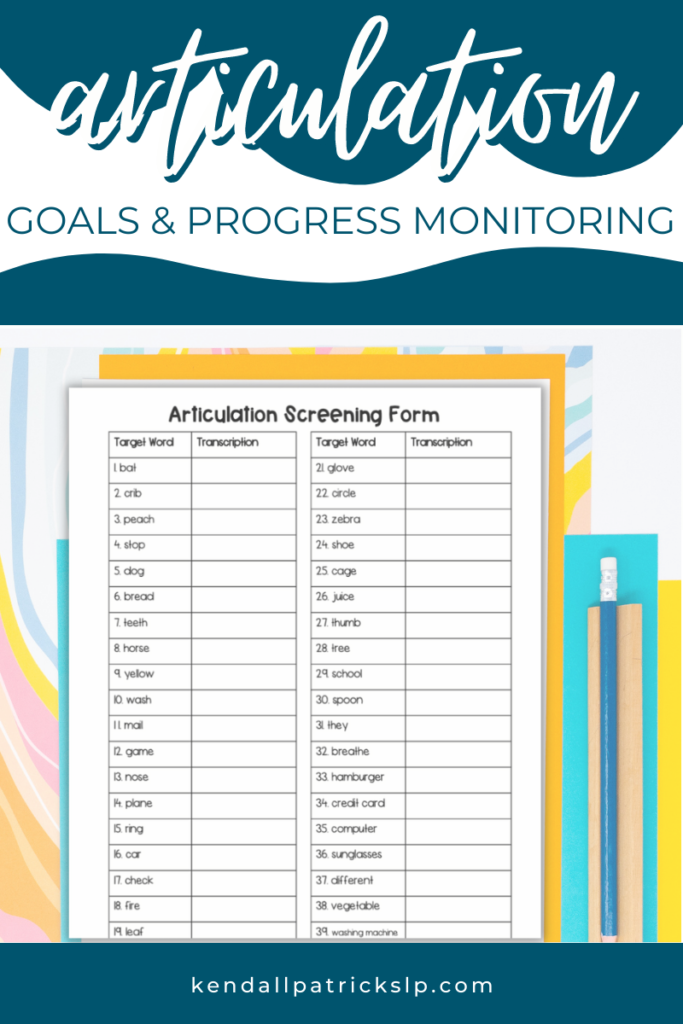
Speech Therapy Articulation Goals
Here are some examples of how I write articulation goals:
- STUDENT will accurately produce ____ sounds in isolation, words, and phrases with 90% accuracy across 3 therapy sessions as measured by therapy data and progress monitoring.
- During structured therapy tasks, STUDENT well accurately produced CVCVCV words (E.g., animal, tomato) with 80% accuracy as measured by therapy data and observation.
Progress Monitoring Speech Goals
Now, for my students with more severe articulation and/or phonological delays, that’s where it can get a little more tricky. If I were to try to go through every single sound error in every position, it would take forever. I also may not get great information about sound patterns and situations they may struggle/not struggle with – not to mention how incredibly frustrating it would be for the child. For that reason, I use a quick articulation/phonological progress monitoring tool (which also doubles as a screener) to get a snapshot of the child’s overall sound errors. It not only gives me a great place to start but also gives me a quick, visual, easy way to progress-monitor throughout the year and before IEP updates.
Speech IEP Goals Bank
A speech IEP goals bank is a great place to start when writing a new IEP, especially when you are new to the schools. While absolutely IEP goals fro speech should always be individualized, it doesn’t hurt to have a place to start. My IEP goals bank is a brief but inclusive list of a variety of goals that target various areas of speech and language therapy.
Remember, while it is great to have a goal bank in a place to start, you always have to individualize. What is right for one student may not necessarily be what’s right for another. Even when students are working on similar goals they may reach those goals in different ways and at different times. This is where you can individualize percentages, number and types of prompts needed/provided, in what situations, and with what mode of communication.
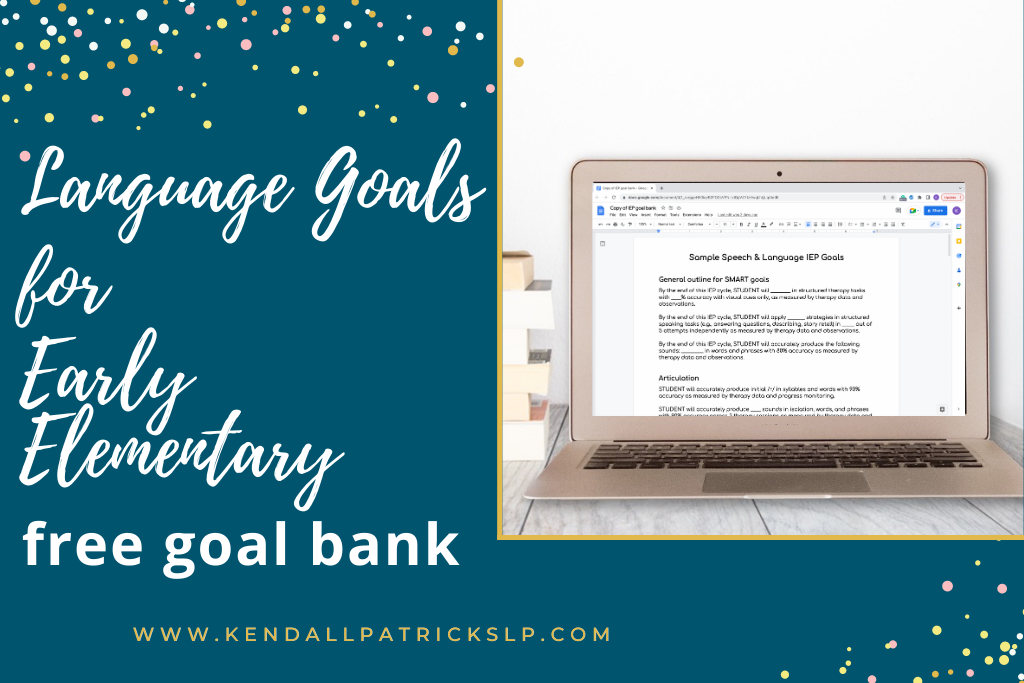
Speech Therapy Language Goals for Younger Populations
Working on story retell and vocabulary are both great ways to get the most bang for your buck in language therapy. Vocabulary knowledge helps to build the foundation for later reading and academic success. Narrative language acquisition helps promote better comprehension as well as use of complex language. When working on narrative language, you are also incorporating grammar skills, social skills, vocabulary, and comprehension all in one.
While these areas are great to work on, sometimes writing goals for them can be tricky. I’ve found it easiest to do it one of two ways:
1. Write a goal for one target you want to address within the goal
1. For example, targeting past tense verbs for grammar while working on retell
2. Or focusing on category words while learning vocabulary strategies
2. Or write the goals for the big picture you want to accomplish
1. For example, STUDENT will retell a simple episode by including 4/5 story grammar components.
2. STUDENT will apply an organizational strategy to describe/define vocabulary by providing at least 3 attributes (e.g., category, parts, function, etc.)

Speech Therapy Language Goals for Kindergarten
By Kindergarten/early elementary, children should be able to retell a simple story, answer questions about the story, AND demonstrate understanding of more components of the story- character/character description, setting, feelings, plot, etc.
At this stage, I may still work on simple word relationships if needed, but I also may move into applying vocabulary strategies to help with organization. So my goals might look like this:
STUDENT will apply an organizational strategy to express 3-4 story grammar parts (e.g., character, setting, problem, ending) following an orally presented story in 3 out of 4 attempts as measured by therapy data and progress monitoring.
Speech Therapy Language Goals for Preschool
In preschool, a child should be able to understand a simple story, as shown by answering questions about the orally presented story and retelling a simple story in sequence.
At this stage, I like to focus on simple word relationships, simple narratives, and basic comprehension (e.g., sorting items in categories, retelling a simple/single episode, answering who and what questions following a story). So my goals might look like this:
Given a sentence starter, STUDENT will express word relationships (e.g., category, parts of a whole, similarities/differences, color) with 80% accuracy.
STUDENT will accurately sequence at least 3 events from an orally presented story with 80% accuracy as measured by therapy data and observation.
Long pin preschool-speech-therapy-language-goals
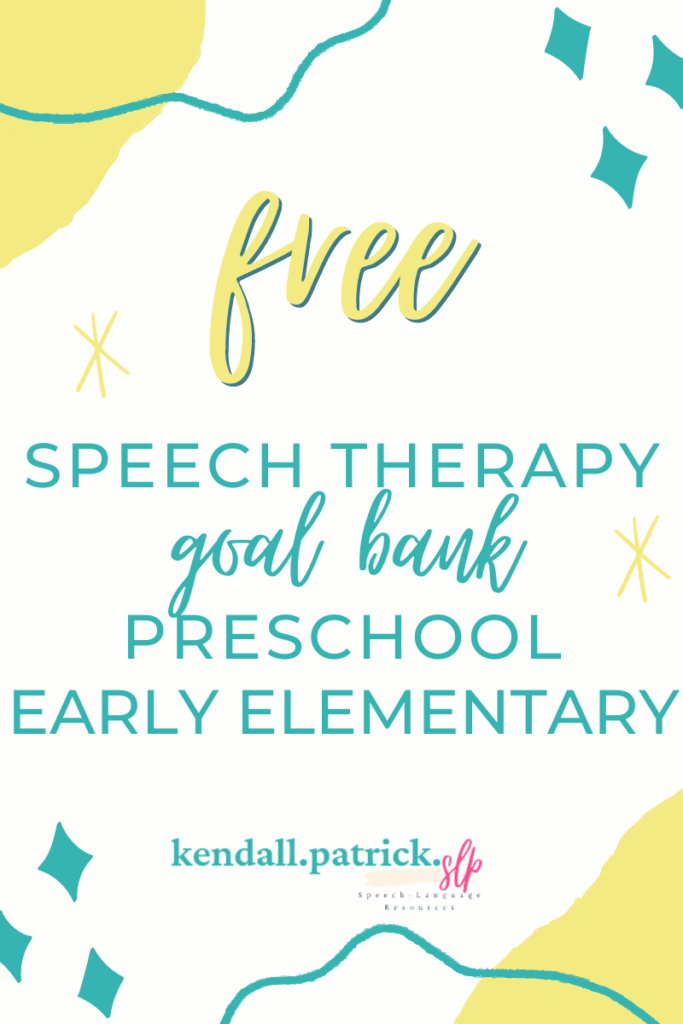
More Preschool Speech Therapy Language Goals
I love using wordless pictures books to work on describing and narrative retell. Because you are not stuck to one story line or one main character, you can work on multiple different story lines and take your therapy targets in any direction. These are some things I might target with a wordless book:
- Character description (use visual strategies and/or graphic organizers)
- Setting description (use visual strategies and/or graphic organizers)
- Sequenced events – use the pictures to guide the story, have a student make it up, generate a story together, or you tell the story and have students retell it using the pictures
- Transition words
- Feeling words – use facial features to describe how they may be feeling
- Drawing conclusions
For more information on speech therapy goal writing:
How to Write Expressive Language Goals [with goal bank] from Communication Community
Speech Therapy Goals for 4th and 5th Graders from The Pedi Speechie
Quick Tips for Writing Speech and Language IEP Goals from Anna Dee SLP
Don’t forget to sign up with your email address here to get access to my free library (growing all the time) full of some of my goodies made exclusively for my followers.
I hope you found some of these ideas helpful and can use one or more in your therapy room. Please leave a comment or shoot me an email if you want to share some of your favorite speech therapy language goals and treatment ideas.
Leave a Reply Cancel reply
Your email address will not be published. Required fields are marked *

hi, I'm Kendall!
I help SLPs like you with planning, resources, research, and materials so that you can spend more time enjoying your therapy time and less time stressing about planning and materials.
Learn more about me and how I can help you here .
Let's Connect!
Access to the freebie library.

Literacy Based Therapy
Speech Sounds
The Bookshelf
Resource library, smart goal bank: elementary.
Goal writing can be tricky sometimes, especially when we are trying to figure just how we want to tackle a skill deficit. Luckily, for some nerdy reason ?, goal writing is my JAM! I always write following a S.M.A.R.T goal format Also SMART Goal Bank. Below you will find examples of Objectives/Short Term (ST) goals.
Please feel free to use any of these as a base to create goals for your students but be sure to align the goals to your student’s timeline and ability ??
Helpful posts to check out before you read: Prompts and Cues…yes, they are different
I have several resources geared to goal writing and data collection. If you feel shaky on goals you may want to check out this mini-course . You can follow my TpT store to make sure you don’t miss any new additions as well as Instagram and Facebook where I frequently share lots of data and goal tips.
TIP: When writing goals for lists ( vocab, categories, labeling, etc ) explicitly state the targeted words you are going to work on in the notes section of the IEP! This will make your data collection a breeze since you will know what to target. If the students masters the list, high five! Create a new list, discuss it will parents ( and IEP team if necessary), complete an amendment to the IEP and keep on rolling.

Expressive Language: SMART Goal Bank
- When presented with a targeted picture, STUDENT will accurately label the picture with no more than two verbal or visual prompt/cues with 80% accuracy or better over three consecutive sessions.
- When presented with a visual field of 4 pictures, STUDENT will accurately label the picture stated by the clinician with no additional prompts or cues and 70% accuracy or better over three consecutive sessions.
- After being shown a picture scene, STUDENT will state the locations of various objects by correctly using spatial basic concepts terms with no more than two verbal or visual prompts/cues and 70% accuracy or better over three consecutive sessions.
- When presented with a picture of a targeted object, STUDENT will accurately state the function of the object with no more than one verbal/visual prompt or cue with 60% accuracy or better over three consecutive sessions.
- When verbally told a list of 3 items, STUDENT will state the accurate category that the items belong to with no more than two verbal or visual prompts/cues and 70% accuracy or better over three consecutive sessions.
- When told given a targeted category, STUDENT will state at least different items that would be included in the category with no additional prompts or cues and 80% accuracy or better over three consecutive sessions.
- After being told a targeted word, STUDENT will state a correct synonym for the word with no more than two verbal or visual prompts/cues and 60% accuracy or better over three consecutive sessions.
- After being told a targeted word, STUDENT will state a correct antonym for the word with no more than two verbal or visual prompts/cues and 60% accuracy or better over three consecutive sessions.
- After being presented with pictures of two items, STUDENT will accurately state at least one way the items are similar with no more than one verbal or visual prompt/cue and 80% accuracy or better over three consecutive sessions.
- After being presented with pictures of two items, STUDENT will accurately state at least one way the items are different with no more than one verbal or visual prompt/cue and 80% accuracy or better over three consecutive sessions.
- After being shown a picture of an object, STUDENT will describe the object by stating at least three different characteristics with no more than one verbal or visual prompt/cue and 80% accuracy or better over three consecutive sessions.
- When discussing a picture scene or event in the past tense, STUDENT will accurately utilize past tense verbs in sentences with no more than verbal or visual prompt/cue and 60% accuracy or better over three consecutive sessions.
RECEPTIVE LANGUAGE: SMART Goal Bank
- STUDENT will accurately complete two-step directions with no more than one verbal or visual prompt/cue with 80% accuracy or better over three consecutive sessions.
- After being read or reading academically appropriate information, STUDENT will identify the correct answer from 3 multiple choice options with no additional prompts/cues with 80% accuracy or better over three consecutive sessions.
SEMANTICS: SMART Goal Bank
-STUDENT will utilize context clue strategies to determine the meaning of unknown words in sentences with no additional prompts/cues and 80% accuracy or better over three consecutive sessions.
-When given a targeted vocabulary word, STUDENT will correctly state the meaning of the word with no additional prompts/cues with 75% accuracy or better over three consecutive sessions.
– When given a multiple-meaning word, STUDENT will state at least two different meanings of the word with no more than one verbal or visual prompt/cues with 80% accuracy or better over three consecutive sessions.
COMING SOON…

©2022 The Speech Bubble SLP. All Rights Reserved.
Designed by ashley hughes..
Now Hiring: Speech Language Pathologists! Learn more ->
Speech-Language Pathology IEP Goals: A Complete Guide and Goal Bank

Introduction
Effective communication is the cornerstone of a student's education and overall development. For some students facing unique communication challenges, Speech-Language Pathologists (SLPs) play a crucial role in paving the way toward proficient communication. Individualized Education Program (IEP ) goals in Speech-Language Pathology serve as powerful tools, uniquely tailored to address each student's specific communication needs. These goals guide educators, therapists, and parents toward a shared destination: empowering students to communicate confidently, express themselves authentically, and navigate both academic and social environments.
In this comprehensive guide we:
- Provide practical insights into crafting meaningful objectives
- Offer a goal bank with real-world examples
- Emphasize collaborative efforts needed to support students on their communication journeys
Understanding Speech-Language Pathology IEP Goals
The term "IEP goals" carries profound significance. An IEP, or Individualized Education Plan, is a personalized blueprint designed to ensure that every student, regardless of their unique challenges, receives an education tailored to their needs. At its heart, IEP goals are the compass guiding this journey, directing educators and specialists toward specific objectives that will help students flourish academically and socially.
Defining IEP Goals: Personalized Pathways to Success
IEP goals are precise, measurable objectives that chart a student's progress in various domains of education. They are not one-size-fits-all; instead, they are meticulously tailored to address the individual strengths and challenges of each student. These goals encompass a wide spectrum of skills, ranging from academic achievements to specialized areas such as Speech-Language Pathology (SLP).
The Role of Speech-Language Pathology (SLP)
Speech-Language Pathology (SLP) offers support for students facing communication difficulties. SLP professionals, known as Speech-Language Pathologists, possess the expertise to diagnose and treat a wide range of speech and language disorders, articulation difficulties, fluency disorders, voice disorders, and more. Their role extends beyond merely helping students articulate words clearly; it encompasses fostering effective communication in all its forms.
The Significance of IEP Goals in Speech-Language Pathology
Within the context of SLP services, IEP goals serve as the foundation upon which Speech-Language Pathologists build their intervention plans. Whether addressing articulation issues, language delays, or social communication challenges, SLPs rely on IEP goals to ensure that their strategies align with the specific needs of each student.
In the sections that follow, we will delve deeper into the art of crafting meaningful and impactful IEP goals in Speech-Language Pathology. We'll explore the intricacies of goal setting, share practical insights into aligning goals with students' unique communication profiles, and provide real-world examples that showcase the transformative power of well-crafted IEP goals.
Certainly! Here's an expanded Section 2 for your blog post on Speech-Language Pathology (SLP) IEP Goals:
The IEP Process: From Referral to Evaluation:
The journey of crafting and implementing Speech-Language Pathology (SLP) IEP goals is intricately woven into the larger landscape of the Individualized Education Program (IEP) process. Understanding this process, step by step, is essential to appreciate the vital role SLPs play in ensuring students' communication needs are met comprehensively.
The IEP Process Unveiled
The IEP process is a structured approach designed to identify, evaluate, and support students with diverse needs. It encompasses several key stages, each playing a pivotal role in shaping the educational experience of the student.
1.Referral: The process begins with a referral, where a student's unique needs are brought to the attention of educators and specialists. This stage is often initiated by teachers, parents, or other professionals who observe challenges in a student's communication skills.
SLP's Role : Speech-Language Pathologists may be among the first to identify communication difficulties and initiate the referral process. Their expertise in assessing speech and language disorders equips them to identify students who would benefit from SLP services.
2. Evaluation : Following the referral, a comprehensive evaluation is conducted to assess the student's strengths and challenges. This assessment involves a multidisciplinary team , which may include the SLP, working together to gather data, conduct tests, and analyze the student's communication abilities.
SLP's Role : In the evaluation stage, SLPs play a crucial role in assessing the student's speech and language skills. They contribute valuable insights into the nature and extent of communication difficulties, helping to inform the development of IEP goals tailored to the student's needs.
3. Eligibility Determination : Based on the evaluation results, the IEP team determines whether the student is eligible for specialized services. If eligibility is established, the team proceeds to create the student's individualized education plan, which includes SLP-related goals.
SLP's Role : SLPs provide critical input during the eligibility determination process, drawing on their expertise to advocate for students who require speech and language support. Their insights guide the team in making informed decisions about the student's eligibility.
4. Goal Setting : With eligibility confirmed, the IEP team, including the SLP, collaborates to set specific, measurable, and achievable goals for the student. These goals are at the heart of the IEP and serve as the foundation for intervention strategies.
SLP's Role : Speech-Language Pathologists take a lead role in crafting communication-related goals that address the student's individual needs. These goals are designed to enhance the student's speech production, language comprehension, or social communication skills.
5. IEP Implementation : Once the IEP is developed, it is put into action. SLPs work closely with the student, educators, and other professionals to implement the strategies and interventions outlined in the plan.
SLP's Role : SLPs are instrumental in delivering specialized services as outlined in the IEP. They employ evidence-based techniques and interventions to support the student in achieving their communication goals.
6. Progress Monitoring : Regular progress monitoring is essential to ensure that the student is making meaningful strides toward their goals. Adjustments to the IEP may be made based on the student's progress and evolving needs.
SLP's Role : Speech-Language Pathologists play a central role in tracking the student's communication progress. They use assessment data and ongoing observations to gauge the effectiveness of interventions, adapting strategies as necessary.
7. Collaboration: Throughout the IEP process, collaboration is key. This extends not only to the professionals involved but also to parents and caregivers who play a vital role in supporting the student's journey.
SLP's Role : SLPs foster collaboration by engaging with parents and other professionals to ensure a holistic approach to communication support. They provide insights, guidance, and resources to empower families in helping their child succeed.
Crafting Effective SLP IEP Goals
In Speech-Language Pathology (SLP), the path to effective communication starts with clear, purposeful goals. These goals act as guides for educators, specialists, and students, leading them toward proficient communication. To do this effectively, create SMART SLP IEP goals—ones that are Specific, Measurable, Achievable, Relevant, and Time-bound.
1. Specific : Tailored to the student's unique needs.
2. Measurable : Trackable for progress.
3. Achievable : Realistic and attainable.
4. Relevant: Address specific communication challenges.
5. Time-bound : Set clear deadlines.
Common SLP IEP Goal Areas
Speech-Language Pathologists (SLPs) play a pivotal role in helping students overcome a wide array of communication challenges. To appreciate the breadth of their expertise, let's explore some of the common domains in which SLPs work their magic:
1. Articulation and Phonology
- Goal : Improve the clarity of speech sounds.
- Example : The student will correctly produce the /s/ and /z/ sounds in words and sentences with 80% accuracy in three consecutive therapy sessions.
2. Expressive Language
- Goal : Enhance the ability to express thoughts and ideas.
- Example : The student will use complete sentences to describe a picture or event, incorporating appropriate vocabulary and grammar.
3. Receptive Language
- Goal : Strengthen comprehension skills.
- Example : The student will follow two-step directions in the classroom environment, demonstrating understanding by completing tasks accurately.
4. Fluency (Stuttering)
- Goal: Improve speech fluency and reduce stuttering behaviors.
- Example: The student will employ smooth, uninterrupted speech patterns during oral presentations, with the ability to self-monitor and implement fluency techniques.
- Goal : Enhance vocal quality and resonance.
- Example: The student will use appropriate pitch and volume levels during conversational exchanges, maintaining vocal health and clarity.
6. Social Communication and Pragmatics
- Goal : Develop effective social interaction skills.
- Example : The student will engage in reciprocal conversations with peers, demonstrating turn-taking, active listening, and appropriate body language.
These are just a few of the areas where SLPs make a profound impact. Each goal is carefully tailored to the unique needs of the student, ensuring that interventions address specific challenges while promoting confidence and proficiency in communication.
In the next sections, we'll delve deeper into these domains, providing further insights and practical examples to illuminate the path toward achieving these goals.
IEP Goal Bank for Speech-Language Pathology
Articulation and phonology.
Preschool (Ages 3-5):
- The student will correctly produce the /k/ and /g/ sounds in initial and final word positions with 90% accuracy in spontaneous speech, as measured by audio recording and analysis.
- The student will reduce tongue thrust patterns, achieving 80% accuracy in structured speech tasks, as measured by audio recording and analysis.
Elementary (Ages 6-8):
- The student will use age-appropriate speech sounds when describing pictures, achieving 100% intelligibility among peers, as measured by peer evaluations.
- The student will maintain appropriate oral posture for speech production, reducing jaw tension and strain, as measured by an SLP's visual observation.
Middle School (Ages 9-12):
- The student will generalize correct /s/ and /z/ sounds from structured activities to conversational speech, as measured by audio recording and analysis.
- The student will improve the production of blends (e.g., "bl," "fl," "sn") in words and sentences, achieving 80% accuracy in structured speech tasks, as measured by audio recording and analysis.
Expressive Language
- The student will use basic vocabulary to express needs and preferences in sentences with 4-5 words, as measured by language samples.
- The student will increase the use of action verbs in spoken sentences and describe sequential events, demonstrating a 100-word vocabulary, as measured by language samples.
- The student will construct complex sentences with conjunctions (e.g., "although," "while") in written assignments, achieving 85% accuracy.
- The student will expand vocabulary by using synonyms, antonyms, and figurative language appropriately in oral and written language, as measured by vocabulary assessments.
- The student will improve narrative skills by generating original stories with a clear beginning, middle, and end, incorporating descriptive details, achieving 90% accuracy, as measured by narrative assessments.
- The student will use persuasive language and argumentative strategies in written essays, demonstrating effective communication of ideas, as measured by written compositions.
Receptive Language
- The student will follow one-step and two-step directions related to daily routines, such as "pick up the crayons and put them in the box," with 85% accuracy, as measured by teacher observations.
- The student will identify objects, actions, and spatial concepts in pictures and respond to "wh" questions (e.g., "Where is the cat?") with 80% accuracy, as measured by language samples.
- The student will listen to short stories and answer complex comprehension questions, including inferential questions, with 90% accuracy, as measured by reading comprehension assessments.
- The student will demonstrate improved auditory memory by recalling and summarizing spoken information, including main ideas and details, as measured by recall exercises.
- The student will use effective listening strategies, such as paraphrasing and asking clarifying questions, during classroom discussions and lectures, as measured by teacher feedback.
- The student will identify figurative language elements (e.g., similes, metaphors, idioms) in written texts and explain their meanings, achieving 85% accuracy, as measured by reading comprehension assessments.
Fluency (Stuttering)
- The student will reduce instances of stuttering by using easy onsets and light contacts during speech, achieving 95% fluency in structured speaking tasks, as measured by audio recording and analysis.
- The student will increase self-awareness of stuttering behaviors and use self-correction strategies, as measured by self-monitoring logs.
- The student will participate in classroom activities that involve speaking in front of peers, demonstrating improved fluency and control, as measured by teacher observations.
- The student will confidently engage in peer conversations, including open discussions and debates, demonstrating consistent fluency, as measured by peer evaluations and recorded conversations.
- The student will use appropriate pitch and resonance in speech, achieving a balanced vocal tone, as measured by audio recording and analysis.
- The student will employ vocal techniques to convey emotions and intentions effectively in spoken language, as measured by audience understanding and feedback.
- The student will improve vocal hygiene practices, reducing vocal strain and hoarseness, as measured by an SLP's visual observation and self-reporting.
Social Communication and Pragmatics:
- The student will initiate and maintain conversations with peers, incorporating turn-taking and active listening skills, as measured by peer evaluations and recorded conversations.
- The student will use polite language and request clarification appropriately during social interactions, demonstrating effective communication, as measured by teacher observations.
- The student will interpret non-verbal cues, such as body language and facial expressions, to understand social contexts and adjust behavior accordingly, as measured by comprehension of non-verbal cues in social interactions.
- The student will engage in cooperative group activities, demonstrating the ability to negotiate, compromise, and resolve conflicts with peers, as measured by teacher observations.
- The student will engage in role-play scenarios to practice problem-solving and conflict resolution in social situations, as measured by performance in role-play exercises.
- The student will use appropriate communication strategies in academic settings, such as seeking clarification from teachers and participating in classroom discussions, as measured by teacher feedback.
In the world of Speech-Language Pathology (SLP), the importance of setting clear and purposeful goals cannot be overstated. These goals act as guiding lights, directing educators, specialists, and students toward the destination of proficient and effective communication. Crafting Specific, Measurable, Achievable, Relevant, and Time-bound (SMART) SLP IEP goals is a transformative step, promoting personalized growth.
Effective communication profoundly influences students' academic and social success. As advocates for students' speech and language needs, we encourage you to champion well-crafted IEP goals. By doing so, we empower students to navigate their educational journey confidently, armed with the indispensable ability to communicate effectively. Together, let's ensure every student's voice is not only heard but celebrated in their journey of growth and achievement.
Want more? Subscribe for access to all free resources
The professionals you need, the flexibility you want.
With live-online services we are able to find related service professionals that will not compete against your ability to hire individuals in-district. We can reach IEP and 504 students from multiple sites, and offer flexible scheduling and pricing options.

Related articles

Parallel Behind the Scenes: Natalie Bianco, M.A. CCC-SLP/L

Navigating Successful IEP Transitions: Planning for Students with Disabilities
.jpg)
How to Create SMART Goals for Effective IEPs
Empowering School Districts with World-Class Providers, Fast
The power of partnership: canton union school district #66.
Students served by Parallel SLPs
Psychoeducational Assessments conducted
Total service hours provided
Unlock the case study

Empowering Excellence: Porterville Unified School District
Increase in SLPs
Increase in services delivered by Parallel

Contact & Support
Follow on Facebook
Connect on LinkedIn
Follow on Instragram
Subscribe on Youtube
All clinical services are provided by licensed physicians and clinicians practicing within independently owned and operated professional practices. For patients in New York and Connecticut, this is known as “Parallel Behavioral Health, P.C.” Parallel Learning, Inc. does not itself provide any physician, behavioral health professional, or other healthcare provider services.
Any call to action with a link here?

Grammar Goals for Speech Therapy (IEP Objectives)
Need some ideas for grammar goals for speech therapy? If you’re feeling stuck, keep on reading! In this post, I’ll provide some suggestions you could use for writing iep goals for grammar and sentence structure. Think of this blog post as an informal goal bank- one you can use to get some ideas for goal writing. Not only that, but I’ll also share some strategies for language intervention.
The important thing to remember is that grammar and syntax are very important areas to target in your therapy room (or classroom, if you do push-in therapy). This is because grammar and syntax affect reading comprehension . Children with language disorders on your caseload will likely need explicit and intentional instruction in this area. P.S. Read this blog post to see speech goals for 4th and 5th graders .

Smart Goals
As a reminder: you know your student best and will want to individualize all goals and make them measurable . This is really an “informal iep goal bank of ideas”. These goal ideas are simply intended to help get your creative juices flowing. Feel free to modify or expand on them . In fact, please do!
If you need help writing a measurable goal, you may want to read about the SMART framework. Smart goals are specific, measurable, attainable, results-oriented, and time-bound. You’ll need to decide on factors like what % progress will be measured, how many consecutive sessions you would like your student to demonstrate that percentage, and by what date you’d like your student to achieve this goal.
To read more about writing measurable IEP smart goals using the SMART framework, read this article from n2y.com .
The Areas of Grammar
Do you feel like you need a quick grammar review? This article explains more about the five areas of grammar , which include:
- punctuation
- tense and aspect
- determiners
Reference: The 5 Fundamental Elements of English Grammar. (2021). Retrieved 13 June 2022, from https://www.englishcollege.com/what-5-elements-grammar
Grammatical Parts of Speech
Speech pathologists are language experts- but we aren’t English teachers! It’s super helpful to have a quick “go to” reference for the 8 grammatical parts of speech. You can access that article here .
- noun (person, place, thing, idea)
- pronoun (a word used in place of a noun)
- verb (action or state of being)
- adjective (a modifier that describes a noun or a pronoun, such as pretty )
- adverb (a modifier that describes a verb, adjective, or another adverb)
- preposition (a word placed before a noun or a pronoun in order to form a phrase)
- conjunction (joins words, phrases, and clauses together)
- interjection (a word that expresses emotion)
Reference: The Eight Parts of Speech- TIPS Sheets- Butte College. (2022). Retrieved 13 June 2022, from http://www.butte.edu/departments/cas/tipsheets/grammar/parts_of_speech.html#:~:text=There%20are%20eight%20parts%20of,as%20grammatically%20within%20the%20sentence.

Verb Tense Review
Do you need a reminder on the different verb tenses? If so, I like this article . There are present, past, and future verb tenses . Verb tense tells us when the action happens. Each of these 3 “main” tenses can be broken down into further components, including simple, continuous, perfect, and perfect continuous .
Speech pathologists often work on verb tense with school-age children.
Reference: Verb Tenses: How to Use The 12 English Tenses with Useful Tenses Chart (2018). Retrieved 13 June 2022, from https://7esl.com/verb-tenses/
Conjunctions Review for SLPs
I wanted to make sure you had a quick reference for conjunctions as well!
I explain that conjunctions are words that join sentences or sentence parts together to my students.
Here are the types of conjunctions:
- coordinating conjunctions (for, and, nor, but, or, so, yet)
- correlative conjunctions (coordinating conjunctions that work as a pair, such as both…and)
- subordinating conjunctions (conjunctions that tell us about cause and effect, time, condition, or concessions)
How I Write IEP Goals for Younger Children
Younger students can- and SHOULD- work on grammar and syntax, too! Verbs are a great place to start when targeting expressive language. In fact, research tells us that focusing on “harder” verbs may be more effective . Therefore, I not only work on labeling verbs in therapy, but I also address grammatical morphemes . I additionally believe that exposure to a variety of sentence structures and sentence types (interrogative, negative sentences, interrogative sentences) during speech therapy sessions is very important.
We can use intervention strategies with young children in language therapy such as direct teaching, modeling, expansion, verbal prompts to use the grammatical target, and recasts .
If you need a quick review, morphemes are the smallest unit of language. There are grammatical morphemes (such as a plural -s ending) and derivational morphemes (prefixes and suffixes).
Early grammatical morphemes can include present progressive -ing (i.e. eating), plural -s (i.e. shoes), prepositions (in, on), possessive ‘s’ (i.e. mommy’s bag), regular past tense -ed, articles, and conjunctions. For a more comprehensive list of grammatical morphemes, see this chart from ASHA .
Our speech goals for grammar and syntax should involve encouraging young children to use more morphemes to create longer utterances. When we don’t use morphemes, the result is telegraphic speech. (Reference: Pence, Khara L. “Building Blocks of Language.” Language Development From Theory To Practice ,” Pearson Education, Inc. , Upper Saddle River, NJ, 2008, pp. 82–101.)
It’s also important to remember that to work on grammatical endings, our students must be able to SAY the required speech sounds. This will likely mean explicit instruction in articulation, which I why I am including articulation goals in this list .
Grammar Goals for Speech Therapy (Preschoolers):
- label actions or pictured actions during play-based activities
- use grammatical markers (i.e. verb + ing) to describe actions or pictured actions
- use present progressive verbs (verb +ing) to describe actions
- create simple sentences using 2-3 word utterances (i.e. agent + action) to show a variety of communicative intents
- express negation (no, can’t, won’t, don’t) in utterances or simple sentences of 2-3 words in length
- ask questions (wh questions, yes- no questions) during play
- use early prepositions (in, on) in simple sentences
- use grammatical markers (i.e. possessive ‘s: the cat’s toy) in sentences
- create complex sentences using conjunctions (i.e. and)
- create spoken sentences containing embedded prepositional phrases
- label common objects using grammatical endings (i.e. plural ‘s ending: toys)
- correctly produce final consonant clusters to indicate a past tense grammatical ending (i.e. /t/, /d/, “id”)
- correctly produce final consonants and/ or final consonant clusters to mark plurals
- correctly produce final consonant clusters to mark possessive ‘s’ grammatical endings
How I Write IEP Goals for School Age Children
What are some good grammar goals for speech therapy with school age children? By the way, I discussed my speech goals for 4th and 5th graders earlier. This blog post, however, specifically is focusing on grammar goals and syntax goals. I’ve already discussed that I feel like it is super important to include morphology in expressive language intervention. That’s why you’ll specifically see some goals devoted to grammatical morphemes and derivational morphemes.
I think there is a huge importance, as well, in teaching our students how to pronounce grammatical endings (especially for past tense and plurals).
Our students also need to know how these grammatical endings will look in print.
For structured language activities that target past tense verbs and morphology, you can check out this grammar program . If you need a resource that addresses a variety of grammar and complex syntax targets for older children, be sure to look into the Entire Year of Grammar and Sentence Structure program .
Grammar Goals for Speech Therapy: School Age Children
- correctly pronounce past tense -ed verbs (sounds like /t/, sounds like /d/, sounds like “id”)
- sort base verbs by the correct past tense suffix ending (d or ed)
- identify the base and suffix within words (i.e. dance/d)
- create the past tense form of a verb by adding a suffix (d or ed)
- use regular past tense verbs at the sentence level to describe actions or pictured actions
- correctly pronounce plural -s nouns (sounds like /s/, sounds like /z/, sounds like “is”)
- retell a short story using transitional words
- explain cause and effect about a picture or story event using causal conjunctions
- use irregular past tense verbs in sentences to describe actions or pictured actions
- sort words into correct piles based on part of speech (i.e. noun vs verb)
- identify parts of speech or sentence parts within sentences
- complete sentence fill-in tasks using targeted parts of speech or sentence parts
- arrange scrambled words into meaningful sentences
- complete spoken/ written sentences using relative clauses
- create a sentence about a picture using a targeted coordinating conjunction
- finish spoken sentence starters using targeted subordinating conjunctions
- use a target word (i.e. adjective) to describe a picture
- add modifiers (i.e. adjectives, adverbs) to spoken/ written sentences
- join sentences or sentence parts together using a target conjunction (coordinating, subordinating) or conjunction pair (correlative)
- create a complex sentence about a picture when provided with a target conjunction
- choose the correct modifier (ie. adjective, adverb) to correctly complete a sentence
- when provided with a dependent clause (i.e. Although I studied…), generate an independent clause to finish the sentence
- create a compound sentence about a picture using a targeted coordinating conjunction
How I Teach Past Tense Verbs in Speech Therapy
In this video , I explain exactly how I teach regular past tense verbs in speech therapy. As I’ve mentioned throughout this post, I like to make sure I’m also addressing morphology. Past tense verbs can be very tricky for our students to figure out. That’s why I like to take a structured approach and really break things down. I make sure to explain what the past tense suffix endings look like and what they mean. We practice sorting verb cards by suffix ending. After that, we practice pronouncing the verbs. I explain the rules for pronouncing past tense verbs to my students. Check out the Past Tense Verbs Program to see how it will be beneficial for your speech therapy students.
- when the base word ends with a voiceless sound, -ed or -d sounds like /t/ (example: laughed)
- when the base word ends with a voiced sound, -ed or -d sounds like /d/ (example: waved)
- when a base word ends with a /t/ or a /d/, -ed or -d sounds like “id” (example: painted)
Addressing Grammar Goals for Speech Therapy Using a Communication Device
Many students in special education may require some sort of aided communication. Whether they are using a communication board or a communication device, be sure to provide that student with access to increasing morphology, grammar, and syntax . This means that it’s a good idea to ensure that a communication system contains grammatical endings, for example. Often, communication boards contain core vocabulary. Core vocabulary is very important, of course. However, we want to increase language skills and help our students share information. To encourage the student to increase utterance length and overall communication skills, they need access to more than just single words. They also need access to grammatical morphemes, derivational morphemes, and grammatical parts of speech, to name just a few things.
My 10 Favorite Resources for Grammar in Speech Therapy
Here is a list of my favorite resources to work on grammar and sentence structure skills in speech and language or special education. These resources are wonderful for the school setting. They can be used in individual therapy sessions or small group.
- Entire Year of Grammar and Sentence Structure (Grades 2-3)
- Entire Year of Grammar and Sentence Structure (Grades 4-5)
- Entire Year of Grammar and Sentence Structure (BUNDLE)
- Regular Past Tense Verbs Program
- Regular and Irregular Nouns Program
- Relative Clauses (Worksheets)
- Causal Conjunctions (Complex Sentences)
- Coordinating Conjunctions
- Subordinating Conjunctions
- Creating Sentences with Conjunctions (Upper Elementary or Middle School)
The Entire Year of Grammar and Sentence Structure
I realize how overwhelming teaching grammar and syntax can be for any speech language pathologist! While I was working with my 4th and 5th graders, I realized I needed a better system for teaching grammar and sentence structure. There’s so much to cover- so, where to start? I realized my language kids simply needed to start with the basics and work their way up. We needed solid visual cues. We needed a system that would start with the basics before moving to compound sentences and complex sentences.

If you’re looking for an organized, effective approach to use in speech, then you’re in the right place! The Entire Year of Grammar and Sentence Structure provides you with a structured activity and lesson to use each week with your students. Try the first lesson here .
You don’t need to “re-learn” everything grammar. SLPs are too busy for that! Spend less time stressing and more time enjoying therapy. This handy program provides you with everything you need to jump in and get started.
The Basic Grammar Program
The Basic Grammar Program addresses areas of concern such as morphology and grammar. This program specifically focuses on teaching regular past tense verbs (-d and -ed) and regular and irregular plurals. Your students will start with the basics. They will learn what the past tense suffixes (-ed, d) and plural suffixes (-s, -es) mean. They will practice sorting words by suffix for increased understanding. Your student will work on pronouncing the suffixes correctly once they have been added to a base word. You can practice creating new words by adding a suffix to a base word to work on morphology. Finally, this program is also unique because it addresses spelling. This will help your student make the “speech to print” connection.

Grammar Worksheets to work on Grammar Goals in Speech Therapy
Do you need grammar worksheets to address specific areas of concern?
Clauses are an important area to address with our students. For students working on relative clauses, these worksheets come with a built-in “scaffolding of skills” support. In addition, they will make your upper elementary students smile as they create “silly” (and sometimes “gross”) sentences.
If you need a structured activity to work on cause and effect conjunctions, your students will love this conjunctions resource . It pairs perfectly with a magnetic wand and chips.
Finally, your older students will love this creating sentences using conjunctions activity. The pictures are not “childish” and are designed to be used with older students. Excellent examples are provided on every page.
Similar Posts
10 tested (and cheap) preschool books to boost language skills.
Are you a speech-language pathologist, preschool teacher, or intervention specialist searching for cheap preschool books? Are you hoping to add new books to your book collection? This blog post recommends 10 children’s books that are engaging and fun for preschoolers. Whether you’re trying to build your book collection, or simply planning to visit your local…
Teaching the R Sound in Speech Therapy
Teaching the R sound in speech therapy can be stressful for a speech therapist. Children with speech sound disorders may have difficulty with saying r words. In this blog post, I’m sharing a simple, 5-step strategy SLPs can use to teach the r sound successfully and without frustration. Many students with articulation disorders have difficulty…

The Best Speech Therapy Worksheets for School SLPs
This article lists the best speech therapy worksheets for school SLPs to use with students.

60 Quick What Questions for Speech Therapy (WH-Questions)
Speech-language pathologists frequently target wh- questions in speech therapy. This article contains 60 what questions for speech therapy that speech pathologists can use during speech therapy sessions. These speech therapy questions contain basic questions and more complex questions. The different questions provided will make it easier to use across your caseload of varying needs and…

8 Fun Language and Articulation Printable Worksheets (that Students Love)
Speech pathologists looking for articulation printable worksheets should check out this blog post! It contains recommendations for speech and language worksheets that will allow SLPs to easily target a variety of articulation sounds during a speech therapy session, as well as language goals! Receptive and Expressive Language Worksheets for Speech Therapy Want some speech therapy…
50 Perfect (and Practical) Why Questions for Speech Therapy- Plus Activities
If you are a speech-language pathologist searching for why questions speech therapy lists and activities, check out this blog post! Many children in speech therapy address wh- questions as a way to target receptive and expressive language skills. Learning how to ask and answer WH questions is a key part of language development. Why questions…
Join Pilot Waitlist

Home » Blog » General » Understanding IEP Goals for Gestalt Language Processors: A Step-by-Step Guide

Understanding IEP Goals for Gestalt Language Processors: A Step-by-Step Guide
Individualized Education Program (IEP) goals play a crucial role in supporting the communication and social-emotional development of gestalt language processors. In this blog post, we will explore the importance of setting specific goals for gestalt language processors and provide a step-by-step guide to developing effective IEP goals. Whether you are a parent, educator, or speech-language pathologist, this guide will help you navigate the process of creating meaningful goals for individuals with gestalt language processing challenges.
I. Introduction
A. Importance of Individualized Education Program (IEP) goals for gestalt language processors
Individuals with gestalt language processing challenges often face difficulties in communication and social interactions. By setting specific IEP goals, we can address these challenges and provide targeted support to help them thrive academically and socially.
B. Overview of the blog post content
In this blog post, we will first delve into understanding gestalt language processing and the unique characteristics of gestalt language processors. We will then explore the role of IEP goals in supporting their communication and social-emotional needs. Next, we will provide a step-by-step guide to developing effective IEP goals, followed by examples of goals related to expressive and receptive language skills, as well as social-emotional development. Finally, we will discuss the importance of collaboration and communication between speech-language pathologists, educators, and parents in achieving these goals.
II. Understanding Gestalt Language Processing
A. Definition and characteristics of gestalt language processors
Gestalt language processors are individuals who have a unique way of processing and understanding language. They often have strong visual thinking skills and excel in seeing the big picture. However, they may struggle with understanding and using language in a sequential and linear manner. These individuals may have difficulty with pragmatics, understanding abstract language, and interpreting non-verbal cues.
B. Challenges faced by gestalt language processors in communication and social interactions
Gestalt language processors may face challenges in various aspects of communication, including expressive and receptive language skills. They may struggle with organizing their thoughts and expressing themselves clearly. Additionally, they may have difficulty understanding and interpreting the intentions and emotions of others, leading to challenges in social interactions and building relationships.
III. The Role of IEP Goals
A. Explanation of Individualized Education Program (IEP) goals
IEP goals are specific objectives that are tailored to meet the unique needs of each individual with gestalt language processing challenges. These goals are developed collaboratively by the IEP team, which typically includes parents, educators, and speech-language pathologists. IEP goals provide a roadmap for intervention and support, guiding the individual’s progress in communication and social-emotional development.
B. Importance of setting specific goals for gestalt language processors
Setting specific goals is essential for gestalt language processors as it allows for targeted intervention and support. By identifying the specific areas of communication and social-emotional development that need improvement, we can create goals that address these needs directly. Specific goals also enable us to track progress and make necessary adjustments to the intervention plan.
C. Benefits of IEP goals in addressing communication and social-emotional needs
IEP goals provide a structured framework for addressing the communication and social-emotional needs of gestalt language processors. By setting goals that focus on improving expressive and receptive language skills, as well as social-emotional development, we can provide targeted interventions that promote growth and success. IEP goals also help in fostering collaboration and communication between the IEP team members, ensuring a holistic approach to support.
IV. Step-by-Step Guide to Developing IEP Goals for Gestalt Language Processors
A. Step 1: Assessing the individual’s strengths and weaknesses
Before developing IEP goals, it is crucial to assess the individual’s strengths and weaknesses in communication and social-emotional development. This assessment can be done through formal evaluations, informal observations, and input from parents, educators, and other professionals involved in the individual’s care.
B. Step 2: Identifying specific communication and social-emotional needs
Based on the assessment, identify the specific areas of communication and social-emotional development that require improvement. This could include expressive language skills, receptive language skills, pragmatics, social skills, emotional regulation, and self-advocacy.
C. Step 3: Setting measurable and attainable goals
Develop goals that are specific, measurable, attainable, relevant, and time-bound (SMART). For example, a goal could be “The individual will increase their expressive language skills by using descriptive vocabulary in 80% of opportunities during structured activities within six months.”
D. Step 4: Determining appropriate strategies and interventions
Identify strategies and interventions that will support the individual in achieving their goals. This could include direct instruction, visual supports, social stories, role-playing, peer modeling, and collaborative problem-solving activities.
E. Step 5: Monitoring progress and making necessary adjustments
Regularly monitor the individual’s progress towards their goals and make necessary adjustments to the intervention plan as needed. This could involve collecting data, conducting progress reviews, and seeking input from the individual, parents, educators, and other professionals involved.
V. Examples of IEP Goals for Gestalt Language Processors
A. Sample goals related to expressive language skills
1. The individual will increase their use of descriptive vocabulary in oral and written communication by incorporating at least three adjectives in 80% of opportunities within three months.
2. The individual will improve their ability to organize their thoughts and express themselves clearly by using graphic organizers or outlines in 90% of writing assignments within six months.
B. Sample goals related to receptive language skills
1. The individual will improve their ability to understand and interpret figurative language by correctly identifying and explaining at least three idioms or metaphors in 80% of opportunities within four months.
2. The individual will enhance their listening comprehension skills by summarizing the main ideas and supporting details of a given passage in 90% of opportunities within five months.
C. Sample goals related to social-emotional development
1. The individual will improve their ability to interpret non-verbal cues and understand the emotions of others by correctly identifying and labeling facial expressions in 80% of opportunities within three months.
2. The individual will develop strategies for managing frustration and regulating their emotions by utilizing deep breathing exercises or self-calming techniques in 90% of observed situations within six months.
VI. Collaboration and Communication
A. Importance of collaboration between speech-language pathologists, educators, and parents
Collaboration between speech-language pathologists, educators, and parents is essential in ensuring the success of IEP goals for gestalt language processors. By working together, we can share information, align strategies, and provide consistent support to the individual. Regular communication and collaboration also allow for ongoing progress monitoring and adjustment of goals and interventions.
B. Strategies for effective communication and collaboration
1. Schedule regular meetings to discuss the individual’s progress, challenges, and adjustments to the intervention plan.
2. Share relevant resources, strategies, and materials that can support the individual’s communication and social-emotional development.
3. Foster open and respectful communication, allowing for the exchange of ideas and perspectives.
4. Encourage active participation and engagement from all team members, valuing their expertise and insights.
VII. Conclusion
A. Recap of key points discussed
In this blog post, we explored the importance of setting specific IEP goals for gestalt language processors. We discussed the unique characteristics of gestalt language processors and the challenges they face in communication and social interactions. We also highlighted the role of IEP goals in addressing their needs and provided a step-by-step guide to developing effective goals. Additionally, we shared examples of goals related to expressive and receptive language skills, as well as social-emotional development. Lastly, we emphasized the importance of collaboration and communication between speech-language pathologists, educators, and parents in supporting gestalt language processors.
B. Encouragement to prioritize IEP goals for gestalt language processors
By prioritizing IEP goals for gestalt language processors, we can provide the necessary support and interventions to help them succeed academically and socially. These goals serve as a roadmap for their progress, guiding them towards improved communication and social-emotional development.
C. Invitation to explore further resources and support
If you are interested in learning more about supporting gestalt language processors and developing effective IEP goals, we invite you to start your EverydaySpeech Free trial. EverydaySpeech offers a wide range of resources, including videos, worksheets, and activities, to support individuals with communication and social-emotional needs. Start your free trial today and embark on a journey towards empowering gestalt language processors.

Related Blog Posts:
Pragmatic language: enhancing social skills for meaningful interactions.
Pragmatic Language: Enhancing Social Skills for Meaningful Interactions Pragmatic Language: Enhancing Social Skills for Meaningful Interactions Introduction: Social skills play a crucial role in our daily interactions. They enable us to navigate social situations,...
Preparing for Success: Enhancing Social Communication in Grade 12
Preparing for Success: Enhancing Social Communication in Grade 12 Key Takeaways Strong social communication skills are crucial for academic success and building meaningful relationships in Grade 12. Social communication includes verbal and non-verbal communication,...
Preparing for Success: Enhancing Social Communication in Grade 12 Preparing for Success: Enhancing Social Communication in Grade 12 As students enter Grade 12, they are on the cusp of adulthood and preparing for the next chapter of their lives. While academic success...

FREE MATERIALS
Better doesn’t have to be harder, social skills lessons students actually enjoy.
Be the best educator you can be with no extra prep time needed. Sign up to get access to free samples from the best Social Skills and Social-Emotional educational platform.
Get Started Instantly for Free
Complete guided therapy.
The subscription associated with this email has been cancelled and is no longer active. To reactivate your subscription, please log in.
If you would like to make changes to your account, please log in using the button below and navigate to the settings page. If you’ve forgotten your password, you can reset it using the button below.
Unfortunately it looks like we’re not able to create your subscription at this time. Please contact support to have the issue resolved. We apologize for the inconvenience. Error: Web signup - customer email already exists
Welcome back! The subscription associated with this email was previously cancelled, but don’t fret! We make it easy to reactivate your subscription and pick up right where you left off. Note that subscription reactivations aren't eligible for free trials, but your purchase is protected by a 30 day money back guarantee. Let us know anytime within 30 days if you aren’t satisfied and we'll send you a full refund, no questions asked. Please press ‘Continue’ to enter your payment details and reactivate your subscription
Notice About Our SEL Curriculum
Our SEL Curriculum is currently in a soft product launch stage and is only available by Site License. A Site License is currently defined as a school-building minimum or a minimum cost of $3,000 for the first year of use. Individual SEL Curriculum licenses are not currently available based on the current version of this product.
By clicking continue below, you understand that access to our SEL curriculum is currently limited to the terms above.

IMAGES
COMMENTS
Expressive language is the ability to communicate thoughts, feelings, and ideas through speech, writing, or other forms of output. It's a crucial component of day-to-day interactions and a foundational skill for academic success and social integration. Speech therapy goals aimed at expressive language focus on enhancing the individual's ...
Expressive Language Goal Bank. (client) will independently label age-appropriate objects with 80% accuracy for 3 data collections. (client) will name a described object with 80% accuracy for 3 data collections. (client) will name 5 items from a category with 80% accuracy for 3 data collections. (client) will imitate 1-2 word utterances 10x ...
Receptive Language [Name] will use a listening comprehension strategy - i.e. visualization, paraphrasing, questioning, association, etc. - to accurately respond to 80% of WH questions about an auditory passage across three consecutive probing sessions.. Given instructions to a classroom task or assignment, [name] will accurately sequence three-step directions containing temporal terms (i.e ...
The purpose of IEP goals is to provide a roadmap for the student's educational journey and ensure that they receive the appropriate support and interventions. When it comes to expressive language development, IEP goals play a crucial role in guiding the therapy process. They provide a clear focus and direction for speech-language pathologists ...
By the end of the IEP, when engaged in a structured activity, X will correctly produce targeted speech sounds (/s/, /f/, final consonants, and 3-4 syllable words) with 80% accuracy measured by observation, 3/4 data collection opportunities per grading period. By the end of this IEP, during structured speech/language tasks, given picture and ...
It is defined as the comprehension and/or use of a spoken (i.e., listening and speaking), written (i.e., reading and writing), and/or other communication symbol system (e.g., American Sign Language).". ( ASHA ). Language can be broken into 2 main areas, receptive and expressive. Receptive refers to listening and reading skills and expressive ...
Let's explore some examples of effective IEP goals for expressive language skills: Goal 1: Increase vocabulary knowledge and usage: The student will learn and use 10 new vocabulary words in daily conversations and written assignments. Goal 2: Improve sentence structure and grammar: The student will demonstrate correct sentence structure and ...
Writing Expressive Language Goals. Below you will find our Communication Community Goal Writing Formula that we use for writing all communication goals (e.g., receptive, expressive, pragmatic, etc.). As seen above, speech goals should be written with 3* components in mind: the DO statement, the CONDITION statement, and the CRITERION statement.
Examples of IEP Goals for Expressive Language Development. Here are some examples of IEP goals for expressive language development: Goal 1: Increase Vocabulary Knowledge and Usage. Objective: The student will learn and correctly use 10 new vocabulary words per month in spoken and written language. Goal 2: Improve Sentence Structure and Grammar ...
How to Write Speech Therapy Language Goals. Goals should be written to be specific, measurable, attainable, relevant and time-based. Let's break some of these down. Speech Therapy Goals for Expressive Language, Receptive Language, and Articulation. Specific - your IEP goals should be specific and define exactly what you were wanting to be ...
Goal 1: Improve vocabulary and word retrieval skills. Targeting specific vocabulary domains, such as academic, social, and functional vocabulary, can help expand the student's expressive language abilities. Strategies like word maps, semantic webs, and word associations can aid in improving word retrieval skills.
IEP goals in speech therapy are essential for several reasons. Firstly, they provide a clear direction for therapy sessions, ensuring that the speech-language pathologist (SLP) focuses on specific areas of improvement. ... Expressive language goals: These goals target the student's ability to express themselves verbally or in writing. They ...
The goal bank includes AAC goals, fluency goals, social language goals, receptive language goals, expressive language goals, articulation goals, and more! Definitely head to the SLP Now Goal Bank to brainstorm IEP goals and objectives for your speech therapy IEP goals. Tips for Speech Therapy Goals 1. Goals must be educationally relevant in the ...
Early Expressive Goal - expanded C. "____ will intelligibly initiate communication with an expanded range of communication partners (measurement over baseline)." Expressive Goal: D. "Within natural contexts throughout the day, _____ will use an increasing number of communicative functions expressively with AAC system/s.
Create a new list, discuss it will parents ( and IEP team if necessary), complete an amendment to the IEP and keep on rolling. Expressive Language: SMART Goal Bank. When presented with a targeted picture, STUDENT will accurately label the picture with no more than two verbal or visual prompt/cues with 80% accuracy or better over three ...
Note 1: Use of the goals assumes the student in question has been assessed and deemed eligible for speech-language services. Note 2: Sample IEP goals are developed to support most content standards for any student who is eligible for speech-language service because of oral communication issues. Note 3: Sample IEP goals can be used with and ...
In Speech-Language Pathology (SLP), the path to effective communication starts with clear, purposeful goals. These goals act as guides for educators, specialists, and students, leading them toward proficient communication. To do this effectively, create SMART SLP IEP goals—ones that are Specific, Measurable, Achievable, Relevant, and Time ...
How I Write IEP Goals for Younger Children. Younger students can- and SHOULD- work on grammar and syntax, too! Verbs are a great place to start when targeting expressive language. In fact, research tells us that focusing on "harder" verbs may be more effective.
These goals are developed collaboratively by the IEP team, which typically includes parents, educators, and speech-language pathologists. IEP goals provide a roadmap for intervention and support, guiding the individual's progress in communication and social-emotional development. ... A. Sample goals related to expressive language skills. 1 ...
American Speech-Language-Hearing Association 2200 Research Blvd., Rockville, MD 20850 Members: 800-498-2071 Non-Member: 800-638-8255. MORE WAYS TO CONNECT. E-mail the Action Center Contact the Board of Directors